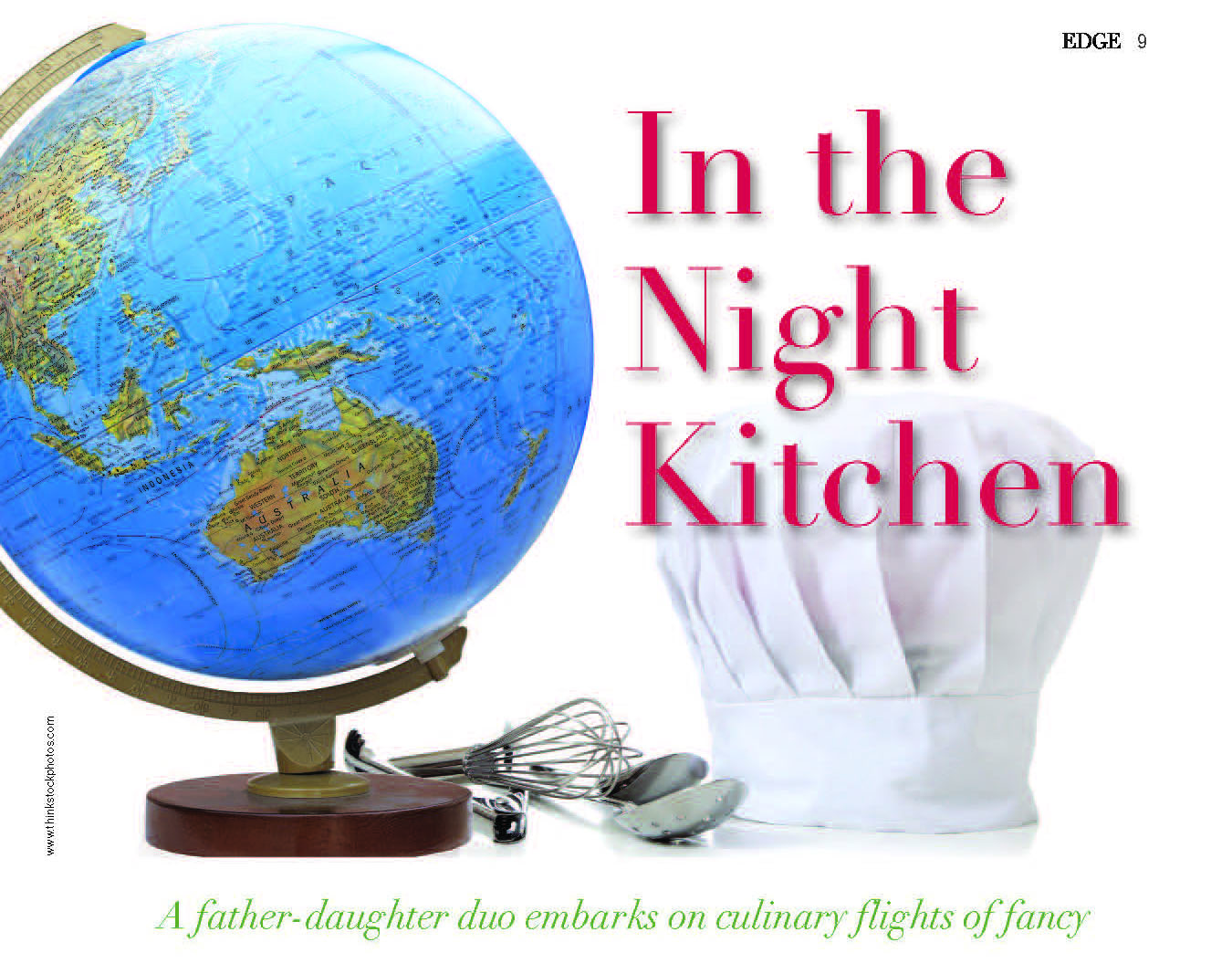
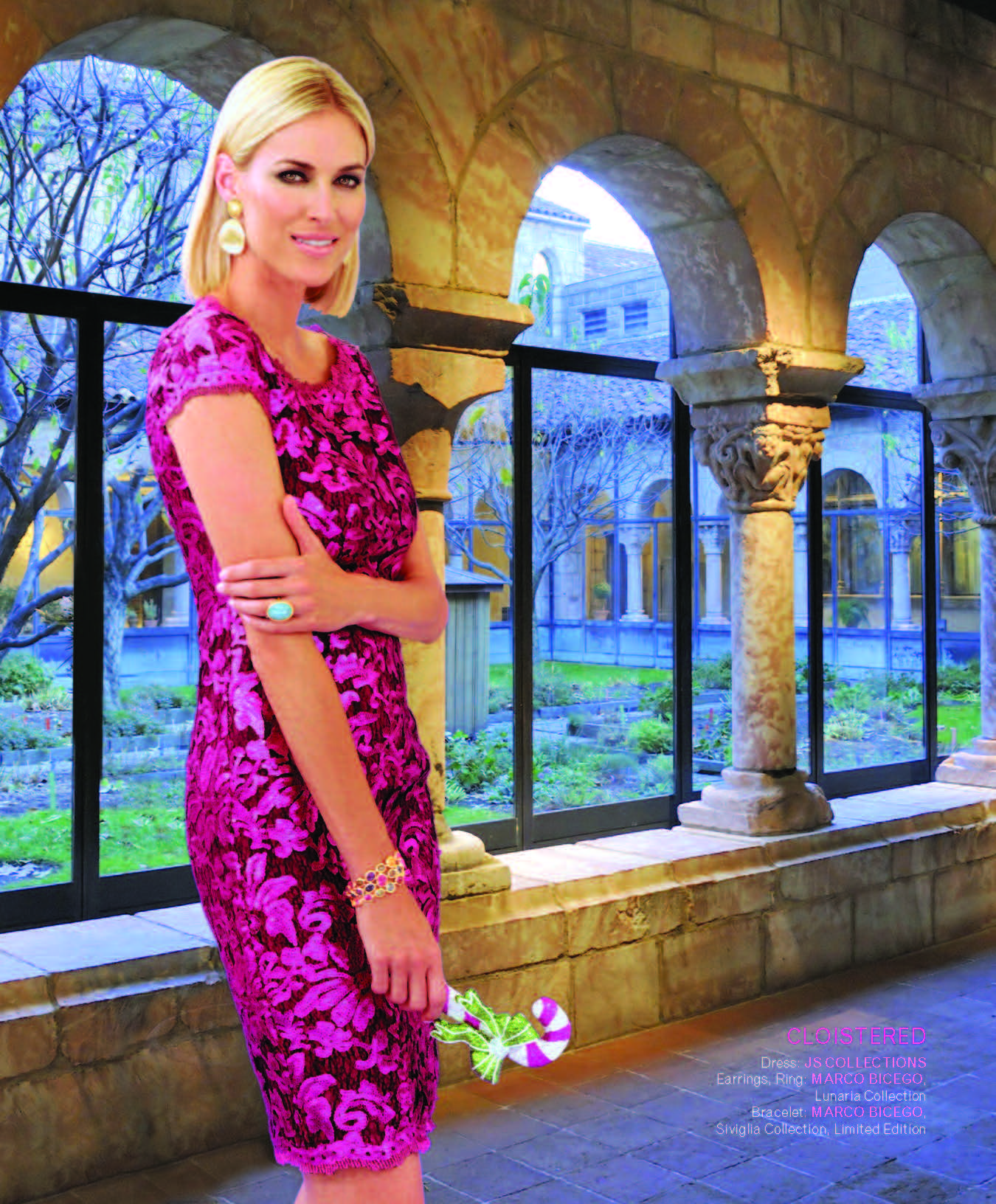



FORE FOR FOURS
(Left photo) Bill Murray, Mike Hannan, Eugene Kennedy, MD, Chair-man of Radiology at Trinitas and Co-Chair of the Trinitas Health Foundation Golf/Spa Classic, and Michael Pantony were among the golfers who helped raise more than $175,000 at this year’s event.
(Right photo) Nick Brown, Tom Pennimpede, Joseph Santo, Principal, Premier Energy Group, LLC, Middlesex and Co-Chairman of the Trinitas Health Foundation Golf/Spa Classic, and Chuck Wilk, paused on the greens at Echo Lake Golf Club in Westfield during the event at which former heavy weight contender Gerry Cooney was a special guest.
WITH TAX TIME AROUND THE CORNER, THERE’S A WAY TO REAP BENEFITS OF GIVING
It’s not too late to cash in on tax savings for 2014! Consider making a tax-effective, high impact gift to Trinitas Health Foundation.
You can qualify for your tax deduction with a gift today or by creating a Charitable Gift Annuity (CGA) that can earn high-interest income for life (and for a second beneficiary, if you c h o o s e ). Through a CGA established with cash, stocks or bonds, you will enjoy an immediate and a long-term tax benefit. If you make a gift of appreciated property, you will only pay capital gains tax on part of the appreciation (which will be spread out over years if you are the annuitant).
Wonde ring what your tax deduction and annual high-interest income might be from a CGA? Call Andi Koenig-Feldman at (908) 994-8249 to find out today.
ring what your tax deduction and annual high-interest income might be from a CGA? Call Andi Koenig-Feldman at (908) 994-8249 to find out today.
A SOLID INVESTMENT
Bank of America continues its support of the Trinitas Health Careers Exploration Program through a $15,000 grant. The bank has made an investment in thousands of young people in Elizabeth and other Union County communities. The ROI?: Thousands of students given the opportunity to explore career opportunities. More than a few successful doctors, nurses and healthcare professionals got their start through this program. Goreti M. Muñoz of Bank of America (center) proudly presented the check representing the Bank’s latest grant to (from left), Lisa Liss, Director of Volunteer Services, Eileen Mulroy, Coordinator of Health Occupations at Trinitas, Nadine Brechner, Chief Development Officer and Vice President, Trinitas Health Foundation, and Jasmine Jones and Kristian Adap, students at Union County Vocational Technical High School who are recent participants in the Health Careers Exploration Program. Photo courtesy of Debbie Jones
 AMAZON SMILE
AMAZON SMILE
If you shop at Amazon.com, you can help Trinitas. Just go to http://smile.amazon.com/ch/22-2353773 and Amazon will donate 0.5% of the price of your eligible purchases to Trinitas Health Foundation. We’re all grins.
IT’S BLACK FRIDAY SOON, SO GIVING TUESDAY CAN’T BE FAR BEHIND…
This holiday shopping season consider opening your wallet to give a special gift to a deserving child.
On Giving Tuesday, December 2, (#GivingTuesday 2014), you can join the Trinitas Health Foundation at the kick off of the Giving season by making a donation by giving the gift of health to less fortunate children.
Your $25 Gift will help provide the quality care that pediatric patients at Trinitas deserve!
Please visit https://www.genestorasp.com/trinitasdonations/secured.aspx. Contact the Trinitas Health Foundatio
News, views and insights on maintaining a healthy edge.
Brown Bagging It
Is your child’s packed lunch getting the job done? A recent report by the Boston Nutrition Obesity Research Center and the National Institutes of Health suggests that it may not. Only 27 percent of lunches brought to school by the 3rd and 4th graders in the study satisfy minimum standards of one ounce of protein, a half-cup of fruit or vegetables, a half-cup of grains and a cup of milk. What’s interesting about these numbers is that the study focused primarily on upper-income families with college-educated parents. In this case, poor food choices are not a function of affluence or education. Among the suggestions nutrition experts offer are packing the lunch the night before, when there is less of a time crunch, and a dedicated section of your fridge for school lunch ingredients.
 Is Obesity the New Normal?
Is Obesity the New Normal?
With all the talk of stemming America’s childhood obesity epidemic, one crucial component has actually gone underreported: the failure of parents to recognize that their child has a weight problem. A 2014 study published in Pediatrics revealed that the percentage of parents who believe their child is “about the right weight” has risen considerably compared to the previous generation—despite irrefutable evidence to the contrary. Parents of girls in a n earlier study (1988 to 1994) said their kids were about the right weight, as opposed to 78 percent of current parents. The increase was not as dramatic for boys (78 percent to 83 percent). However, 37 percent of parents of obese boys said their weight was about right. These numbers worry researchers because children are less likely to lose weight if their parents don’t see a problem. One contributing factor may be that the percentage of obese adults is double the number of obese children.
 Deep 6 BPA
Deep 6 BPA
Despite the fact the FDA has declared Biphenol A (BPA) to be safe, mounting concern about its long-term effects on the brains and behavior of young children has many parents opting to be safe rather than sorry. “Technology has given us many advances in the food and beverage industry,” says  Dr. Kevin Lukenda of Trinitas Regional Medical Center. “Responsible parents need to stay on top of—and be aware of—the possible downside of these conveniences. We need to always remind ourselves that certain products may make our lives easier…but need to know which of these advances can be a risk to our health.”
Dr. Kevin Lukenda of Trinitas Regional Medical Center. “Responsible parents need to stay on top of—and be aware of—the possible downside of these conveniences. We need to always remind ourselves that certain products may make our lives easier…but need to know which of these advances can be a risk to our health.”
BPA is an industrial chemical used to create rigid plastic products—including food and beverage containers, as well as some dental sealants and register receipts. A number of studies are under way, but until their results are in, here are some basic precautions parents can take:
- Never microwave in plastic containers.
- Get rid of any container marked with a #7 or marked PC.
- Store food in glass, ceramic or steel containers instead of plastic.
- Cut down on processed food purchases at the grocery store—most come in plastic packaging.
- Bring your own bags to the store. California recently banned plastic ones. New Jersey should, too.
 E-Lim-I-Nate the Negative
E-Lim-I-Nate the Negative
A recent study conducted at Carnegie Mellon University found that too many negative social interactions can trigger bouts of inflammation that overwhelm a person’s adaptive system and lead to hypertension in older adults. The study (which focused on subjects 50 and older) defined these interactions as involving excessive demands, criticism, disappointment, or other unpleasantness with partners, children, family members, and friends. The effects appear to be more serious among individuals between 51 and 64, and among women in general. One way to manage these situations—besides avoiding them, if possible—is to practice stress-management techniques, including paced breathing and meditation. “The research coming from Carnegie Mellon indicating that unpleasant or demanding interpersonal encounters increase hypertension risk among older adults should come as no surprise to any of us,” points out Rodger Goddard, PhD, Chief Psychologist and Director of Wellness Management Services at Trinitas. Dr. Goddard adds that controlling stress should be very high on one’s priority list. “We cannot become monks and live in a cave in the mountains, so we need to deal productively with what is in our lives,” he says. Stress management involves using both passive and active tools and skills. Passive skills involve improving the capacity to calm our body and muscles down all throughout the day, and involve deep-breathing, stretching, muscle softening and self-calming thoughts all day long. Active skills involves using:
Rodger Goddard, PhD, Chief Psychologist and Director of Wellness Management Services at Trinitas. Dr. Goddard adds that controlling stress should be very high on one’s priority list. “We cannot become monks and live in a cave in the mountains, so we need to deal productively with what is in our lives,” he says. Stress management involves using both passive and active tools and skills. Passive skills involve improving the capacity to calm our body and muscles down all throughout the day, and involve deep-breathing, stretching, muscle softening and self-calming thoughts all day long. Active skills involves using:
- Tough Thinking to fight against and banish our negative worries and emotions
- PIPS (Problem Identification Problem Solving) to dwell on the solutions to our difficulties and not on the problems
- Radical Self-Support to build social skills, avoid the negative interactions cited in the study, nurture ourselves, resolve conflict and get our need for love and support filled
 Your Germs, My Germs
Your Germs, My Germs
The next time you check into a hotel or motel and start thinking about all the icky-sticky bacteria you’re being exposed to, consider this: Within 24 hours of check-in, that room will be microbiologically identical to your home. According to the recently released Home Microbiome Study by the Argonne National Lab in Chicago, the bacteria you carry with you does a remarkable job wiping out whatever the previous occupant left behind. “Those who travel regularly, or even just occasionally, tend to be very suspicious of their environment when they check into a hotel, whether it’s in Des Moines or Dubai,” observes  Michelle Gillis-Harry, RN, MPH, CIC, Director of Infection Prevention and Control at Trinitas. “By using a sanitizing spray or a disinfectant wipe that kills germs, you create a line of defense against germs that others leave behind. But, based on the findings of this study, as you close the hotel door behind you, you’re leaving your own unique microbial imprint. Simply put, we all leave our mark on the places we live, visit, work or play. It’s part of being human and living within the complex environment we call the Earth.” The true potential of the Chicago study (and others in the works) may be in forensics, since microbiological evidence left by humans may be more useful than fingerprints.
Michelle Gillis-Harry, RN, MPH, CIC, Director of Infection Prevention and Control at Trinitas. “By using a sanitizing spray or a disinfectant wipe that kills germs, you create a line of defense against germs that others leave behind. But, based on the findings of this study, as you close the hotel door behind you, you’re leaving your own unique microbial imprint. Simply put, we all leave our mark on the places we live, visit, work or play. It’s part of being human and living within the complex environment we call the Earth.” The true potential of the Chicago study (and others in the works) may be in forensics, since microbiological evidence left by humans may be more useful than fingerprints.
 Trinitas Joins Elite Group of Palliative Care Programs
Trinitas Joins Elite Group of Palliative Care Programs
Earlier this year, Trinitas received the Joint Commission’s Advanced Certification status for its Palliative Care Program, becoming just the fifth medical center in New Jersey to attain this distinction. TRMC’s multidisciplinary team—which includes medical specialists, nurses, pain management specialists, chaplains, social workers respiratory/physical/speech therapists and nutritionists—was singled out for having demonstrated exceptional patient- and family-centered care, optimizing the quality of life for patients with serious illness. Gary S. Horan, President and Chief Executive Officer, praised the work of the team, noting that their commitment to achieving the Advanced Palliative Care Certification was “a tribute to their dedication to these patients and families who need this highly specialized compassionate care. ”According to Valerie Ramsberger, RN, MSN, ACHP—who initiated, developed and directed the Palliative Care Program—in recent years, palliative care has become a specialty that melds the unique skills of a broad spectrum of healthcare professionals dedicated to relieving pain and other symptoms in the most challenging of circumstances. Ramsberger (at center, above), who recently retired as Director of Palliative Care at Trinitas, began the qualifying process more than three years ago by participating in collaborative activities with the Greater New York Hospital Association (GNYHA), Institute for Healthcare Improvement (IHI), and the New Jersey Hospital Association. Geraldine “Magie” Cruz, RN, MSN, CCRN—an ICU staff
FLU SEASON
It’s that time of the year again. Winter is around the corner and flu season—which can stretch from October to May—is already well under way. As Benjamin Franklin once stated, “ An ounce of prevention is worth a pound of cure.” The key to avoiding the flu is prevention. The cornerstones of flu management are based on a three-pronged approach: getting vaccinated, washing hands well and often, and protecting others by staying at home if infected. Once you’ve contracted the influenza virus, the best cure is time. The virus will typically last from 7 to 10 days. It’s important to manage a fever with acetaminophen or ibuprofen and to keep well-hydrated. Antiviral therapy (for example, Tamiflu) started within two days of symptom onset has been reported to decrease the length of the flu by one or two days. However, there is much debate within the medical community as to whether or not antivirals play any role at all. Consult your healthcare provider to determine the appropriate plan of action in your scenario. But first things first…
Who should get vaccinated?
If you are reading this, the answer is almost certainly You. The exceptions would be babies under 6 months, people with allergies and active asthma—need to discuss their options with their physician to determine an appropriate plan of action (i.e., those with an egg allergy)—and those with weakened immune systems, who might be best served to receive the Inactivated Influenza Vaccine (IAV) as opposed to the Live Attenuated Influenza Vaccine (LAIV).
So there are more than one kind of flu shot available?
Yes. You will need to discuss the most appropriate option for yourself with your physician, taking your age and medical history into account. The most common options are:
- Standard Dose Trivalent Shot (Contains Killed Viruses). This shot is approved for people ages 6 months and older.
- High-Dose Trivalent Shot (Contains Killed Viruses). This shot is approved for people ages 65 and older. As we age, our immune system becomes less robust. The aging immune system can lack the necessary immune response to combat the flu. The high dose flu-shot contains three times the exposure (antigen) to the virus resulting in a more immunogenic response to the flu.
- Trivalent Shot (Standard) contains 2 Influenza A strains and 1 Influenza B strain
- Quadrivalent Shot contains 2 Influenza A strains and Influenza B strains
- Nasal Spray Flu Vaccine (Contains Live Viruses). The CDC recommends this as an option for healthy children from ages 2 through 8 years old, as studies have shown that nasal sprays are more efficacious than the flu shot in children in this age group.
Do I need to get vaccinated every year?
Yes, you do. Researchers isolate the top three flu viruses that will be most prevalent each season and create one flu vaccine. Therefore, you need to get a new flu shot every year to make sure that you are protected. Ninety percent of deaths related to the flu occur in people 65 years of age or older, so it is especially important for this group to get annual vaccinations.
How does the flu actually spread?
The flu virus is contained in droplets. The flu is spread when an infected person with the flu sneezes, coughs or talks. As with most viruses, it spreads from our hands to our nasal and oral cavities.
What’s the best way to avoid getting the flu?
If you are sick, stay home from work, school or daycare. It is imperative to practice excellent hand-washing hygiene in order to prevent the spread of the flu. A helpful tip is to wash your hands with soap and water for approximately 15 seconds—the same time it takes to sing the Happy Birthday song. You can also use an alcohol-based hand rub.
What are the common symptoms that tell me I’ve got the flu?
Cough, runny nose, stuffy nose, sore throat, fever, fatigue, muscle aches, vomiting and diarrhea.
How do I know when to seek medical attention?
If you are at the extremes of age, pregnant or have multiple co-morbid conditions such as diabetes, COPD, asthma—or if you are immuno-compromised—get to the doctor the instant you suspect you have the flu.
Editor’s Note: John D’Angelo, DO, is the Chairman of Emergency Medicine at Trinitas Regional Medical Center. He has been instrumental in introducing key emergency medical protocols at Trinitas, including the life-saving Code STemi, which significantly reduces the amount of time it takes for cardiac patients to move from the emergency setting to the cardiac catheterization lab for treatment.
EV-D68
Enterovirus-D68 was first detected in California in 1962. It occurs less frequently than other types of Enteroviruses (EV), which can be difficult to distinguish from any of the viruses that cause the common cold.
The viruses are called “Entero” because they enter the body through the stomach or intestinal tract. There are over 100 types of EV, which affect 10-15 million people each year in the U.S. The strain in question was identified as D68 in August by the CDC. More than 40 states have confirmed respiratory cases caused by EV-D68. In the state of NJ, there are a total of nine laboratory-confirmed cases as of October 3. The counties affected included are: Sussex, Essex. Passaic, Middlesex, Mercer, Morris, Camden and Burlington counties. EV-D68 was detected in specimens from four patients who have died and had samples submitted.
What are symptoms of EV-D68 infection and how is it spread?
Symptoms are nearly indistinguishable from the common cold—cough runny nose, sneezing, body aches and sometimes fever. Severe symptoms include difficulty breathing, wheezing and worsening of asthma. Enteroviruses can be found in secretions from the nose, mouth and through the entire gastrointestinal tract. The virus spreads from person to person via fecal oral contamination, coughing, sneezing or by touching your hands to your face after touching infected surfaces.
Are children at particular risk?
They are. Little ones get their hands in everything. Children are in close contact with one another. Whereas most adults have been exposed to the many types of Enterovirus—and over time, our immunity strengthens and we are able to combat the assailant—infants, children and adolescents lack the immunity necessary to fight the virus. Children with reactive airway disease are particularly susceptible to EV-D68. Parents of children with asthma should use particular vigilance. If their child becomes ill or has increase in his/her work of breathing they should consult their healthcare provider. Adults can contract the virus, of course, but are less likely to become very ill. Even so, EV-D68 can masquerade as the flu or any other “cold-like” illness. Medical professionals view EV-D68 as a possible cause of severe respiratory illness. If you, a member of your family or community experience a new onset of difficulty breathing or shortness of breath, please seek medical attention.
Can it be treated with antibiotics?
No. Antibiotics treat bacteria, not viruses. A patient will be treated by supportive care—namely medications for breathing, fever control and hydration. Practicing proper hand hygiene is paramount to protecting yourself and others. Wash with soap and water for 20 seconds, especially after changing diapers. Hand sanitizers are not effective against Enterovirus. Avoid contacting your eyes, nose, and mouth with unwashed hands. Cough or sneeze into a tissue or an elbow as opposed to an uncovered space. Keep your children or yourself at home if you are not feeling well. Disinfect high-traffic household items such as bathroom surfaces, countertops and toys with bleach-based household cleaners. EV is resistant to alcohol disinfectants. Look for products that list “Alkyl dimethyl benzyl ammonium chloride” as the active ingredient on the label. The product should state that it kills norovirus and rhinovirus.
Should my child stay home from school if I suspect EV?
Parents should never send a sick child to school. And they should not return to school until they are symptom-free and fever-free, meaning a temperature less than 100 degrees for 24 hours without fever-reducing medications.
Breast cancer ‘co-pilots’ help to steer the ship through treatment and recovery.
Too often, cancer treatment is complex and the added stress of making one’s way through myriad mazes of treatment options, insurance forms, doctors’ appointments, and various medical procedures can sap a person’s energy that would be better spent on fighting the disease. Several years ago, Trinitas Comprehensive Cancer Center recognized that many women with breast cancer were in need of a “navigator service” that would help them cut through the red tape surrounding their treatment. Breast cancer patients, Trinitas administrators surmised, would be able to best articulate their concerns and challenges to compassionate healthcare professionals, who could then direct them toward resources designed to help manage the disease. An innovative program was initiated, which showed promising results. Two years ago, the program was revamped to sharpen its focus, resulting in the Breast Cancer Patient Navigator program.
Veronica C. Vasquez, MHA, CN-BA, (left) heads the Breast Cancer Patient Navigator program at Trinitas and works to provide seamless care coordination while considering the unique needs of each patient. “The program helps facilitate patients’ access to doctors’ appointments, deal with insurance claims, and directs them to complimentary transportation and other supportive services,” she says. “Finally, a breast cancer patient navigator offers much-needed emotional support to patients at all phases of breast cancer treatment.”
One of the most frustrating parts of any medical treatment is getting answers to questions in a prompt manner. The Breast Cancer Patient Navigator program helps patients obtain answers to their queries regarding screening, diagnosis, treatment, insurance claims, follow-up visits, clinical trial participation, referrals, transportation, supportive services, and any other concern that may arise. It also assists patients in finding information on self-education resources, and with accessing community resources and cancer management services.
“We also direct patients to support groups that have been shown to help boost emotional well-being while providing coping mechanisms from others who have gone through cancer treatment,” adds Vasquez.

Breast Cancer Navigator, Veronica Vasquez, brings thoughtful caring and support to patients, as shown in the photo on page 44. From her office that overlooks the City of Elizabeth, she manages each patient’s case during their treatment at Trinitas.
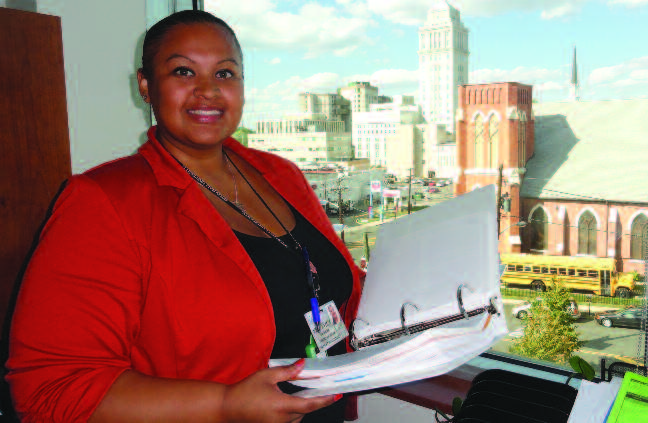
Breast Cancer Navigator, Veronica Vasquez, brings thoughtful caring and support to patients, as shown in the photo on page 44. From her office that overlooks the City of Elizabeth, she manages each patient’s case during their treatment at Trinitas.
Dacia Gaillard, 43, who was diagnosed with breast cancer this past August, calls the Navigator program “a godsend.” Referred to the program by her physician, she gave it high marks and said it has enabled her to cope with a potentially overwhelming and stressful situation. “I am amazed by the amount of compassion I receive,” she says. “I feel reassured that I am not just a name or a number.”
In addition to helping navigate her way through doctors’ visits and insurance queries, Gaillard explains that she can count on Vasquez to “hold her hand” throughout the often long, and arduous, process. Vasquez had her first personal encounter with breast cancer in 2011, when a beloved aunt was diagnosed with Stage III IBC (inflammatory breast cancer). “Not only was it a life altering moment for her but for the entire family, as she was the first member of the family to receive a cancer diagnosis,” she recalls. “She passed away in 2012, but her legacy lives within all those she encountered, forever.”
At the time, Vasquez—who earned her master’s degree in health care administration from Seton Hall—never dreamed that she would have the position that she holds today. “Having had a close family member diagnosed with breast cancer, I hold the work I do to help these women in high regard,” she says. “I dedicate the work I do in loving memory of my aunt, who I miss greatly.”
There’s no time to spare when responding to a stroke.
You’re having a normal day, going about everything as usual, not giving much thought to what might possibly create issues. You are convinced you have everything under control. You certainly don’t give any thought to the fact that you might become a statistic: Every 40 seconds, someone in the United States experiences a stroke; every 4 minutes, someone dies from one.
Let’s get back to your day. First, you start to feel your face drooping. Next, there is a weakness in your arm. You speak but your words don’t make sense. Don’t wait a moment longer. Time is critical. Call 911 for help.

Bernard Schanzer, MD, Chairman of the Division of Neurology, and Debbie Milkosky, RN, Coordinator of the Trinitas Primary Stroke Center, review a CT scan that reveals the presence of a stroke. With decades of experience, Dr. Schanzer serves as the primary neurological consultant for stroke cases at Trinitas, while Debbie seamlessly brings together a team of medical and nursing professionals to address the treatment and care of stroke patients throughout the medical center.
The American Stroke Association has summed up these symptoms in the acronym FAST to encourage a greater awareness of stroke (also know as brain attack). Those who suffer stroke notice a drooping in their Face (F), followed by Arm (A) weakness, and then Speech (S) abnormalities. These symptoms—and others, such as loss of balance or severe headache—mean it’s Time (T) to to call 911.
The person who is symptomatic (experiencing some or all of these symptoms) may be taken so off guard that an observer is often better able to act quickly and place that call. Whatever the case, stroke leaves little time for hesitation. In fact, the longer the delay, the greater the chance for brain damage; approximately 2,000,000 brain cells (neurons) die every minute a stroke goes without treatment.
This past October 29th was World Stroke Day. Now in its ninth year of international observance, it calls attention to what can be a life-altering or fatal health emergency. Statistics bear this out. The Centers for Disease Control and Prevention (CDC) report that one of every 19 deaths is caused by stroke—taking the lives of nearly 130,000 Americans each year. The disability that results from stroke costs the nation $38.6 billion annually; that’s a hefty price tag that includes health care services, medication and lost productivity. Although the American Stroke Association emphasizes that 80 percent of all strokes are preventable, uncontrollable risks such as heredity, age, gender and ethnicity remain key factors that can lead to stroke.
 Root Causes
Root Causes
Strokes occur when a blood clot blocks the blood supply to the brain or when a blood vessel within the brain bursts. Medical conditions such as high blood pressure, high cholesterol, heart disease, diabetes, being overweight or obese, and previous “mini strokes” (transient ischemic attacks, TIAs), can all exert negative influences and cause someone to be a candidate for stroke. Of the 795,000 people who suffer stroke each year, 610,000 are first or new strokes; 185,000 are recurrent strokes.
That being said, positive lifestyle choices—such as avoiding smoking and excessive alcohol, eating a balanced diet, and getting regular exercise—can all make a difference in reducing the risk of stroke.
Neuro is called,” she says, “an Emergency Room physician evaluates the patient within 10 minutes of arrival. Within the next five minutes, a neurological consult takes place to determine the likelihood of stroke. Based on the neurologist’s recommendation, a patient may be given a clot-busting medication. At 25 minutes after arrival, a CT scan is done. The results are then interpreted within 45 minutes of the patient’s arrival. All of this happens so rapidly because every minute counts in reducing brain damage.”
Education = Prevention
Trinitas’s targeted education plays a pivotal role in pointing out the dangers of stroke and, ultimately, in lessening the frequency of Code Neuros. Trinitas has conducted community outreach that shares information with an average of 700 people each year. With the assistance of the Rotary Club of Elizabeth and a grant from the Rotary District 7510 of Central Jersey, Trinitas created educational resources for family members and friends who may be caregivers to a stroke patient.
In addition, Milkosky and a team of healthcare professionals wrote and produced a video that drives home the important points about acting FAST in the stroke situation. The video follows a patient from the moment he begins to experience initial stroke symptoms through his arrival at the emergency room, to his treatment, and, ultimately his discharge in the care of loving family members. “We’ve put a face on stroke that makes it real for viewers,” she explains.
Milkosky realizes that little can be done to reduce the likelihood of stroke based on genetics, age, gender and ethnicity. However, a better-informed community has a greater chance of striking a blow against stroke. “We conduct cholesterol and glucose lab testing, blood pressure and pulse checks, and offer stroke-related counseling to encourage a better understanding and awareness of stroke.”
She stresses being pro-active to reduce the risk of stroke by eating better, exercising regularly, and avoiding tobacco and alcohol. “In the case of stroke, long-term commitments to healthier living can sometimes help avoid a devastating health crisis that can literally happen in an instant.”
The grandkids are coming…is your home ready?
How long has it been since I’ve had to worry about child-safety in my home? It seems like lifetimes ago that my own babies and toddlers began to explore their environment. And, in a way, I guess you could say it has been. Alas, the clock has kept ticking and I now have come full circle, with children of varying ages starting to descend once again. I believe I speak for all grandparents when I say that I’m ready for all the love and laughter they bring with each visit. The question is, is my adults-only house safe and sound for these home invasions?
Having recently been introduced to my “grand-dog”—a 3- month old Golden Doodle gifted by my son to his two children—I am impressed that childproofing and puppy-proofing have much in common. Both species require one to take the time to think ahead in order to identify and eliminate unhealthy but irresistible attractions, any vulnerable but off-limits personal items, any unidentifiable yet edible crumbs (and other easily digested floor debris), and certainly any potentially dangerous household items capable of being ingested or harmfully dispensed. So much to consider; so little time to correct…especially since the little barbarians are already at the gate.
The lapse of time between my children and my children’s children is enough to make me feel very insecure about how to eliminate juvenile HazMat. In theory, I should be able to slip back into my parental shoes and see my world as they do—a house of potential horrors. Or perhaps, I could regress even further and evaluate domestic terror from the standpoint of a toddler. I am reminded, in fact, of a very dear friend and neighbor who, upon being advised that my two-year old grandson had hidden the TV remote, fell on all fours and crawled through my house, explaining that she felt a toddler’s eye view would ultimately reveal the well-hidden device. And so it did! However, I can’t imagine me, as someone who is definitely more knee-challenged these days, performing such a physically demanding search. There must be a better way.

www.ithinkstockphotos.com
An Accident Waiting to Happen?
About 2.3 million children are accidentally injured every year and more than 2,500 are killed in what seem to be “perfectly safe” homes. Unintentional childhood injury statistics are alarming, as evidenced by a 2012 report from the Centers for Disease Control:
- Every hour, one child dies from an injury.
- About 1 in 5 child deaths is due to injury.
- Every 4 seconds, a child is treated for an injury in an emergency department.
The above statistics reflect not only accidents that occur in the home, but also external tragedies such as car crashes and fires. According to the KidsHealth web site (kidshealth.org), household injuries are responsible for the majority of ER visits for children under age 3; 70% of accident fatalities in children under 4, not surprisingly, occur where the very young spend most of their time: at home.
 SAFETY WATCHDOGS
SAFETY WATCHDOGS
Safe Kids Worldwide (www.safekids.org)
Safe Kids has an extensive network of more than 500 domestic and 25 international coalitions that are dedicated to reducing childhood injuries and fatalities. Since it was co-founded in 1988 by Dr. Marty Eichelberger (Children’s National Medical Center) with support from New Brunswick-headquartered Johnson & Johnson, the accidental injury rate among children 19 years and younger has decreased by 56%.
International Association for Child Safety
(www.iafcs.com)
The mandate of IAFCS is triple-fold:
- Encourage manufacturers to produce higher quality child-safe products.
- Educate parents on home safety issues.
- Enhance professionalism among child safety professionals through certification of professional providers.
US Consumer Product Safety Commission
(www.cpsc.gov)
A conservative estimate of the CPSC is that child and adult deaths, injuries, and property damage from consumer product incidents cost the nation more than$1 trillion annually. Over the past 40 years, CPSC has successfully protected consumer families’ children through its vigilance in identifying a long list of unsafe products to include cribs, strollers, bicycle helmets, pajamas, and innumerable toys and gadgets.

www.ithinkstockphotos.com
There is some very good news. Even though Safe Kids Worldwide (www.safekids.org) has reported that the estimated number of emergency room visits for children has increased 31% over the last decade, the CDC has reported that the number of childhood fatalities from injury has dropped nearly 30% over the same time period. Thankfully, most accidents are preventable and much is being done to prevent them. According to a recent National Safe Kids’ Report to the Nation, many factors have contributed to the dramatic decline in the accidental childhood fatalities:
- Recognizing that child injury is a preventable public health issue.
- Educating the public through campaigns at the national and community levels.
- Improving safety devices through ongoing R&D and encouraging their use.
- Collecting feedback from “child-proofers,” both private and professional, to develop even safer new products.
- Enacting and enforcing child safety laws.

www.ithinkstockphotos.com
What can you, as a grandparent (or non-parent caretaker) do to keep those numbers moving in the right direction? Create a safety-product checklist that applies to your particular situation. It should include standard-issue items such as safety gates, kitchen and bathroom cabinet safety locks, corner and sharp edge bumpers, doorknob covers and door locks, outlet covers and outlet plates, window guards or safety bars, doorstops and door holders (to prevent fingers getting caught), wall brackets (to secure tip-able furniture and TVs to the wall), safety hinges on toy chests and window seats, and non-skid bathtub strips.
Once you’ve covered the basics, consider safety precautions that are not always obvious. These include outdoor alarms made for pools, gates and doors, blind winders and drapery cord cleats, anti-scald devices for baths and taps, safety netting for balconies and decks, appliance locks for dishwashers and stoves, safe-locked storage for firearms & ammo, toilet lid locks, and fire escape ladders. If your grandkids are “regulars” at your home, you should consider enrolling in an infant & child CPR class (or at least purchase a how-to DVD). And if you own a dog or other animal that is threatened by little ones, talk to a professional pet consult to understand how you can desensitize your pet.
Big Business
Professional childproofing has evolved into a very lucrative business over the past two or three decades. So perhaps it’s time to turn to the pros for some advice—hopefully accompanied by some reasonable housecall pricing. Industry experts recommend that child-proofing be done before a child can crawl (typically at 3-6 months). According to the pros, the six main areas of focus for proofing purposes are:
- Electrical safety
- Physical access
- Chemical access
- Medicine access
- Fire safety
- Reporting potentially dangerous products
As with most professional home services, the cost for childproofing comes with a price tag. An initial at-home consultation typically ranges between $50-$100. Actual services rendered depend upon the size and safety conditions of each home. Complete packages can begin as low as $300, but can easily soar to $1,500 or more. As an example, the typical two-bedroom/two-bath apartment might cost $300-$600, whereas a suburban two-story home can reach the top of the price scale.
Professional Proofers…
These NJ-based childproofing experts confirm that business is booming:
A–Plus Childproofing • Jersey City apluschildproofing.com
Baby Proofers Plus Inc. • Summit babyproofersplus.com
Home Safe Home • Livingston homesafehomenj.com
Royal Baby Safety Corp • Summit
babysafe.com
Home Safe Home
Whether you’re brand new at the baby game, a seasoned parent of a rollicking group of toddlers (and their slightly older siblings), or proud grandparents of a growing second-generation brood, the houseproofing challenge remains the same. The responses to this challenge can vary, from complete paranoia to a somewhat less vigilant “my kids survived, so will theirs” attitude. Personally, I am closer to the former than the latter. I am not sure whether it is the added generational difference or a bit of senior OCD that makes creating the perfect germ-free, chemical-free, hazard-free home environment such an inordinate obligation for me. Thinking back, I question whether I was this conscientious? To be honest, probably not.
Ironically, after paying a visit recently to my grandchildren’s home, I found myself somewhat taken aback by what I considered to be their parent’s rather laid-back attitude toward houseproofing. I actually noticed a sharp table corner missing a buffer cushion, an electrical outlet with a safety plug dangling, and a kitchen cabinet with a childproof lock unlocked. Hard to admit, but it does remind me somewhat of my own home back when my kids were as young as their children are now. It was a reminder of how easy it is to let things slide as an overwhelmed parent.
Even with the most vigilant and meticulous household policing, there’s always the potential for some danger to be overlooked or to go unsuspected. Even the most painstaking household safety campaign is never as effective as the ever-watchful eye of an alert and devoted caretaker, regardless of the generational relationship. Despite the most intensive childproofing protocol, vigilance is the real secret. And, of course, that primordial responsibility does not stop within the confines of our homes.
Finally, in my hyper-vigilance to ensure that my home is not a toddler trap, I think I’ve discovered an additional benefit. I’ve started thinking very realistically about the safety measures I might want to take in anticipation of growing old in this very same home. Indeed, down the road, my “senior-proofing” project should be much easier after everything I’ve learned. Just one change—no more childproof caps!
Editor’s Note: According to Safe Kids Worldwide, a non-profit organization based in Washington DC, last year suffocation was by far the major cause of fatal childhood accidents—including 77% of the deaths under the age of 1. Choking and falls came next, followed by furniture and TV tip-overs and fatal injuries caused by toys.
“A feisty, rather luxurious eggplant curry, ennai kathrikai, may have been my favorite dish of the night.”
Karaikudi
1671 Oak Tree Road, Edison. Phone: 732.516.0020
Open Monday through Friday for lunch from 11:30 a.m. to 3 p.m. and Saturday and Sunday noon to 4 p.m. Dinner: Monday, Wednesday through Saturday from 5:30 to
10 p.m., Sunday from 5:30 to 9:30 p.m. and Tuesday dinner buffet from 6:30 to 10 p.m. Major credit cards accepted. Call to inquire about reservations.

Karaikudi isn’t your average restaurant groupie’s trend-of-the-minute, Instagram-ready hot spot. It’s posh in a traditional way, neither deliberately un-decorated nor all-out artfully attired in a manner that attracts the “Well, I-was-there-last night” crowd.
No, Karaikudi, located in a large parking lot behind one of many shopping centers on Oak Tree Road in Edison, is a rare-for-America Chettinad restaurant, specializing in the little-known cuisine of a region in the state of Tamil Nadu, in Southern India, where typically vegetarian food reigns and spices star.
Yet Chettiars, the people of Chettinad, are not vegetarians. They do not eat beef or pork for religious reasons, but they are huge fans of fish, chicken, lamb and goat. They celebrate spice arguably with more passion than any people in the Spice Belt of South India, and serve their spices, including a variety of chilies, not in fiery doses but by skillfully integrating them into their dishes.
Karaikudi, where members of the New Jersey Indian community and the devoutly food-centric congregate, is a favorite of James Beard Award- winning chef Floyd Cardoz, whose landmark restaurant Tabla brought high-style Indian fare to New York City. It’s where learning something new in food is a delight.
Two of my favorite dining companions, Lily Mullen, 15, and May Mullen, 13, made the trip from Ocean County to experience foods completely foreign to them at Karaikudi. They’re not exactly novices in the kitchen, serving as extremely able sous chefs during my own recipe-testing projects and helping their parents, Eileen and Shannon Mullen, with nightly dinners. They also win 4-H awards for the produce they raise in their extensive backyard garden and for the chickens they’ve nurtured for years. As they efficiently combed Karaikudi’s menu, asking questions both pertinent and probing, I thought to myself, “These two could teach a CIA grad a thing or five.”
We quickly dug in. I could’ve eaten five portions of a signature Chettinad dish, Gobi 65, aka chili-infused cauliflower. Lily coated her tongue and tummy with a silky, creamy mango lassi, which she describes as a lovable “milkshake-like drink,” before, during and after the Gobi 65. It was, she said, “covered in the crispy coating of orange spices that looked like nothing I’ve ever eaten before.”
“They both were deliciously different,” Lily said of the lassi and cauliflower. “I soon realized that Indian cooking has very spicy flavors or mild, simpler ones.”
In other words, Lily caught on to the very essence of Indian fare: balance. If you drink a yogurt-based fruit lassi as a counterpoint to a chile-powered dish such as Gobi 65, you’ll catch flavor not fire.
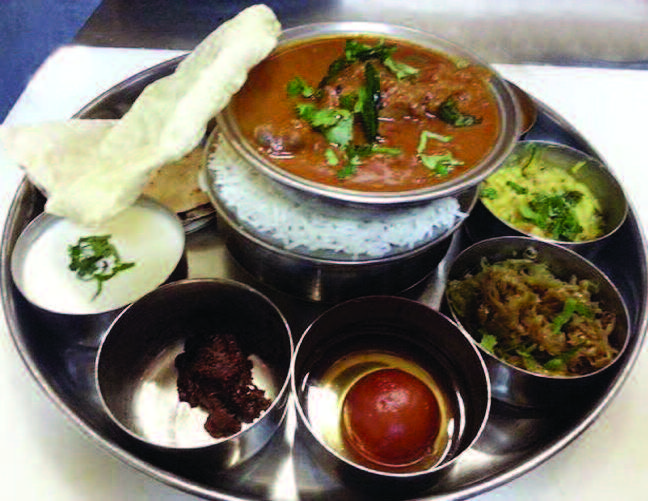 May took a liking to a playfully presented starter called chicken “lollypops.” Dusted in masala, it was a textbook example of how a classic spice mixture can energize a basic such as chicken.
May took a liking to a playfully presented starter called chicken “lollypops.” Dusted in masala, it was a textbook example of how a classic spice mixture can energize a basic such as chicken.
“The chicken lollypops were my favorite dish,” May said.
“The color, the taste, the spiciness and flavor just really hit the spot.”
Mysore bonda, a warming lentil stew enriched with chilies and served alongside coconut dumplings, is something I’d curl up to gladly on a rainy night. May, not a fan of coconut, thought the dumplings a tad bland. But she’d happily reprise the chicken biryani, which was a far more spice-roused rendition than the stuff too often doled out at restaurants without Karaikudi’s finesse.
“The chicken biryani was intriguing!” she exclaimed. “It’s unlike anything I have ever tasted. It wasn’t too spicy or too bland.” Lily summed it up by saying, “The chicken rice with the egg dish looked like what I imagined Indian food to look like.”
I always imagine a banquet of India’s unfailingly gregarious vegetables as a perfect meal, and I’d want Karaikudi’s paneer 65, spiced and fried cheese, on any groaning board. With black pepper and ground chilies as key components, neither one overpowering the other, this is Indian cheese taken to a new level.
A feisty, rather luxurious eggplant curry, ennai kathrikai, may have been my favorite dish of the night: Eggplant stewed with onions, tomatoes and chilies in a tamarind-based sauce proved tart, tangy and inviting as a side show to both the bone-in mutton kurma, a casserole of goat in a silky cashew gravy, and butter chicken, another saucy-yet-sassy stew of chicken with a creamy tomato-infused base.
“Out of the five gravy dishes we tried, the fish one was my favorite,” Lily said. For her, the Chettinad fish curry, with kingfish simmered in a multifaceted masala, bested the chicken, mutton, eggplant and pea-cheese sauce-rich dishes.
Fish curries are a specialty of Chettinad cuisine, so Lily’s spot on in her assessment. Karaikudi’s shows off its spice know-how, fusing seasonings warming and soothing in a way that lends depth to the finfish. I could’ve eaten that dish all night.
I have to admit that I was most excited to watch Lily and May have a proper experience with both a dosa and an uthapam – specifically a paper masala dosa and an onion uthapam. The paper dosa, a large, lacy and extremely light crepe made with rice flour and, in this case, stuffed with potatoes and onions licked by masala, prompted Lily to say it had “the texture of a French fry.” May enjoyed the dosa, but thought the filling “a little too spicy.” The onion-flecked uthapam, often dubbed an Indian “pizza,” is made with a rice flour-lentil base and is thicker than a pancake. Lily enjoyed it straight, no chasers — without “dips,” as she cleverly termed the chutneys, sambhar and raita that accompanied our food.

Pineapple kesari, anyone? That’d be a pineapple semolina pudding that’s a kind of second cousin to a fruited bread pudding. Gulab jamun? Snap up these milk dumplings soaked in rose-flavored sugar syrup at Karaikudi. Both desserts are sweet, yes, but not cloying, particularly the gulab jamon, which Lily referred to as “pancake balls.” They “seemed daunting at first, yet they tasted like a pancake soaked in syrup.”
The only dish we all didn’t take to was billed as chakara pongal and described as a “beet halwa.” It wasn’t like the chakara pongal I’d had before, a very sweet crumble-esque dish starring nuts, dried fruits, basmati rice, milk and lots of jaggery (palm sugar). This shredding of beets was sweet without counterpoint, which set it apart from Karaikudi’s norm.
And Karaikudi’s norm is food so transporting, a dinner here is as good as a stamped passport.
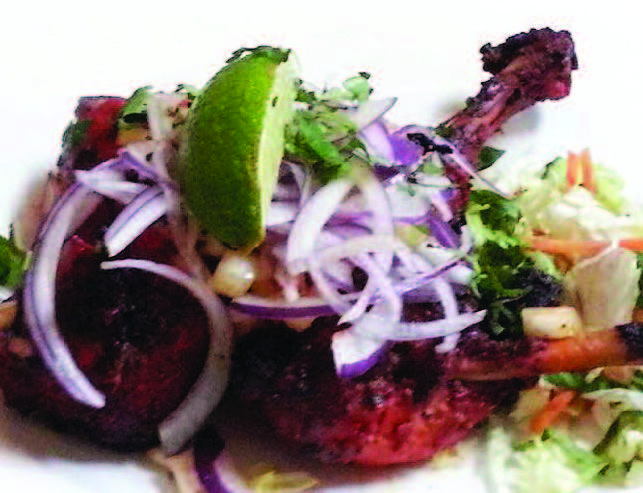
Editor’s Note: The ritual of the International Night dinners that became the cookery book of the same name by Mark Kurlansky and his daughter Talia omits India only by fate. In all the spins of the globe that directed the Kurlansky family to their cooking destination, somehow Talia’s finger didn’t land on the sizable country of India. So we filled in the gap for the many, many devotees of Indian cuisine in Edge-land.
A father-daughter duo embarks on culinary flights of fancy
In March 2009, when Talia Kurlansky was 9, her father Mark spun a big globe with an airplane as its base that sat on a desk in their Manhattan apartment…and let his daughter’s finger fall where it may. That fateful fall of the finger dictated what was to become a family ritual: a dinner menu culled from the cuisine of a foreign land. Fifty-two menus later, the fruits of the family’s ritual have become a joint father-daughter book, International Night (Bloomsbury; $29), a globetrotting adventure in food, history and culture.
Mark Kurlansky is one of the most respected and decorated writers in America, author of The New York Times best-sellers that include Cod, Salt, The Big Oyster, The Basque History of the World and 1968—as well as a host of adult fiction and children’s books. Talia, now 14 and a freshman at The Calhoun School in New York, may not (yet) have her father’s catalog of books, but in her debut with International Night, she explains in a voice both sure and entertaining how to separate an egg, why spaghetti Bolognese is her favorite dish, who grills the best sardines and
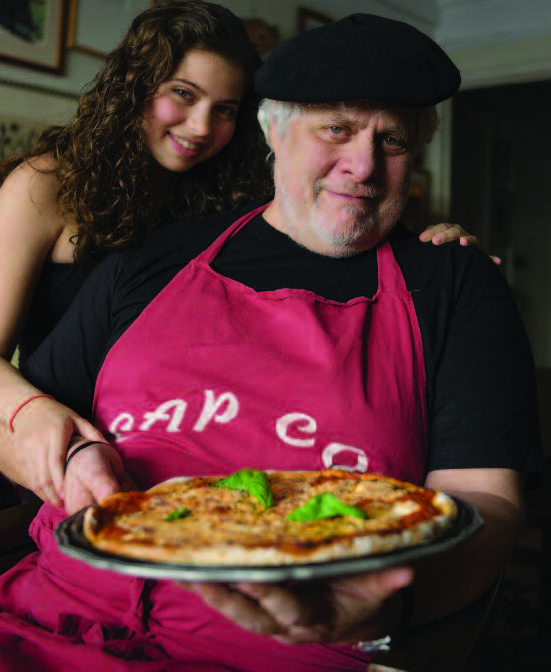
Courtesy of Mark Kurlansky
what steps are necessary to achieve a perfect pizza made from homemade dough tossed, softly and gently, in the air (“Try not to let the dough land on the dog, or in a potted plant. But the dog usually loves it”).
International Night is a book that schools would be wise to include in their curriculum, and parents in their home library. The Kurlanskys’ experiences—both in the cooking (“I tried dishes we don’t normally make in our house,” says Talia; “Some recipes in this book are ones I’ve made for years, but have refused to share until now,” adds Mark) and the off-the-beaten path traveling—are primers in how to learn.
“I’d been to 41 of the places in the menus,” Mark says of the bills of fare that range from Andalusia, Algeria, Aquitaine and Argentina to Quebec, Sri Lanka, Tanzania and Turkey. “That left 11 where I’d never been.”
All international dinner nights involved homework. Mark and Talia researched culture, customs and cuisines, and made sure music was part of the evening’s festivities. Talia added another component: costumes.
“I’d learn what traditional dress and what the outfits were like, and I’d use things from our home to come up with a costume I’d wear for International Night,” she says.
“Kids contribute a lot of ideas through the questions they ask,” Mark notes.
“I got a great sense of the timeline of history and a realistic sense of place,” Talia adds. Her mother Marian took hints of history and culture to guess which country her family was traveling to via the edible route.
Sometimes, when Talia’s finger landed on a destination, the end result was a trip. As Mark writes in their book, “When I learned that for the first time in history there was a cooking school in Morocco, I decided that Talia and I had to go.” They studied with dadas, women trained by their mothers in the crafts, secrets and recipes of Moroccan cookery. They cooked with their dadas several hours a day, taking in the sights and curiosities of this North African country in their non-kitchen time.
“While on this trip, I went up a level in my cooking,” Talia writes. When it came time to write a menu, “we realized that we had too many dishes [for just one dinner], so we had two Morocco Nights.”
Morocco may have served forth a bounty for the Kurlanskys, but every aspect of the project brought insight and new skills to the father-daughter team. Talia talks of using the back side of a ladle to spread crepe batter around a pan: “Move the ladle in a circular motion and that spreads the batter evenly.”
Mark, whose expansive knowledge of all things culinary has brought him honors from the James Beard Foundation, Bon Appetit magazine, the National Council of Teachers of English and National Parenting Publications, still marvels at the “universality of salt,” and points out that “peppers are different everywhere (because), like wine, they taste differently everywhere they are grown,” and offers tips on spices such as cardamom: “It gives dishes a magical perfume, but get the green, not the white.”
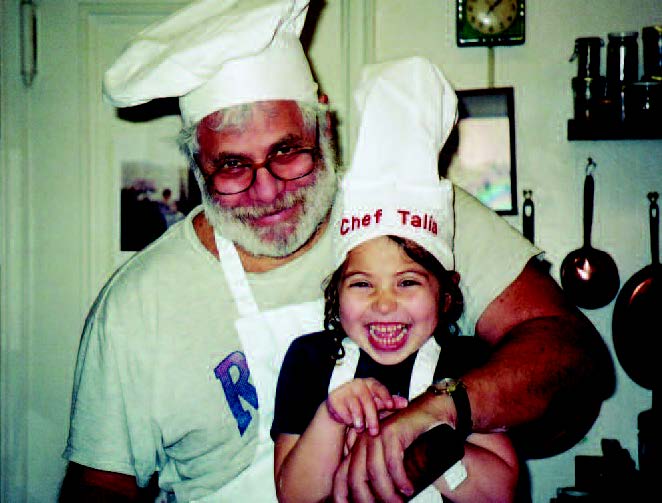
Courtesy of Mark Kurlansky
International Night also offers the recipe for Mark’s prize dessert, “Rigo Jancsi” from Hungary, which he spent weeks perfecting during a stint in the 1970s as a chef at a restaurant in Greenwich Village. The cake was easy, the chocolate topping not all that hard to learn, but “I worked on the filling for weeks, trying, throwing it out, trying again.”
Finally, Mark got it.
As Talia says, “A lot of people making dessert don’t understand the chemistry. They don’t use a recipe.”
But with most of the savory recipes in International Night, the Kurlanskys agree the instructions should be “suggestions.” Home cooks should let inspiration flow.
Researching for the book, and cooking for the book, left Talia with an even stronger desire to travel. “I love being places where I don’t speak the language,” she says. “I want to travel everywhere.”
Mark, who currently is writing a book about the impact of paper on civilization and whose Twitter handle is @codlansky, wishes Talia’s finger had landed on Scotland, since he spent time there fly-fishing and had many tales to tell—and India, a huge country he’s yet to explore.
What? Never been to the land virtually ruled by his beloved spices?
“No,” Mark says, his voice expressing regret. “I’ve never been to India. We need to correct that.”
International Night…the sequel.
 RECIPE FILE: HARIRA* (a soup for Moroccan Night)
RECIPE FILE: HARIRA* (a soup for Moroccan Night)
- one-half pound lamb, cut into bite-size pieces
- 2 medium white onions, finely minced
- one-half pound dried lentils
- one-half cup canned chickpeas (aka garbanzo beans), drained and rinsed
- 1 celery rib, finely minced
- 6 tablespoons olive oil
- Large pinch salt
- one-half teaspoon turmeric powder
- 1 teaspoon clarified butter
- 9 cups water
- 3 medium tomatoes
- 1 slice fresh ginger root, peeled and chopped
- 2 tablespoons tomato paste
- 4 turns of peppermill containing black peppercorns one-quarter cup rice, cooked
- 3 tablespoons flour
Place the lamb, onions, lentils, chickpeas, celery, 3 table-spoons olive oil, salt, turmeric and clarified butter in a pot. Cook over medium heat for 10 minutes.
Add the water. Cook over medium heat for one hour.
Meanwhile, take the tomatoes, blacken the skin over a burner, and rub it off. Quarter the tomatoes and remove the seed and gel. Save yourself a lot of chopping by pureeing the tomatoes in a food processor with the ginger root.
Mix in a bowl with the tomato paste, remaining 3 tablespoons olive oil and the black pepper. Add this mixture to the soup pot. Stir well and cook another 20 minutes. Add the rice. Cook 10 minutes more.
Take some liquid from the soup and mix it in a bowl with the flour until it is smooth and without lumps. Stir it back into the soup. Stir constantly while cooking soup for another 5 minutes. Serves 3.
Growing Pains?
Maybe not. A look at the cost of LBP in kids.
What is the leading cause of disability in the world today? The answer, according to the World Health Organization’s 2010 Global Burden of Disease study, is low back pain (LBP). LBP is defined as pain in the area on the posterior aspect of the body, from the lower margin of the twelfth ribs to the lower gluteal folds, with or without pain referred into one or both lower limbs that lasts for at least one day. The common image of an LBP sufferer is a hard-laboring adult, or a senior citizen, but the fact is that low back pain in children and adolescents is a significant health problem, too.
As Dr. Naomi Betesh points out, in children and teens, back pain increases with age. And because LBP in adolescents leads to increased risk of recurrence in adulthood, physicians are realizing the importance of early detection and treatment in the pediatric population.
“Patients, whether adult or pediatric, have the best outcomes with a multidisciplinary treatment approach,” explains Dr. Betesh, a pain management and rehabilitation specialist at Union County Orthopedic Group in Linden and Clark. “Treatment strategies include core strengthening, postural training, proper biomechanics education, medication management and minimally invasive procedures.”
The 2010 WHO study, which was released in March 2014, concluded that LBP causes more global disability than any other condition. With the planet’s aging population, the report stated, “there is an urgent need for further research to better understand LBP across different settings.”
LBP: DID YOU KNOW?
- The annual bill for chronic pain in America, which includes healthcare costs plus lost productivity, is more than $600 billion.
- More than 15% of that cost is related to lower back pain.
- In 2014, 1 in 34 Americans will lose two weeks or more in productivity to LBP.
- Only one-third of the annual cost of LBP in America is related to healthcare; lost wages and diminished productivity accounts for the remaining two-thirds.
Editor’s Note: The above statistics were part of a 2013 study that included information sourced from the CDC, the Center for Medicare & Medicaid Services and the U.S. Bureau of Labor Statistics.
 MAKING STRIDES IN WESTFIELD
MAKING STRIDES IN WESTFIELD
The EDGE Magazine crew—Rob Rubilla, Jeff Shanes, Doug Harris and Jama Bowman—man the Trinitas booth at the 13th Annual Downtown Westfield 5K & Pizza Extravaganza in July. Around 2,700 runners crossed the finish line moments before the skies opened up for a group cool-down. Trinitas was a Platinum Sponsor of the 5K. EMTs Jose Caba, Angela Boyd & Jon Abello led the runners off the start line in a Trinitas ambulance. Harris, Vice President of Marketing and Public Relations at Trinitas, presented awards to the top finishers along with Sherry Cronin, president of the Downtown Westfield Corporation.
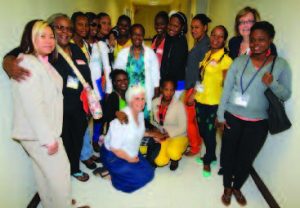 WIDE WORLD OF NURSING
WIDE WORLD OF NURSING
Two faculty mem-bers and 12 nursing students from the University of Notre Dame in Jacmel, Haiti, spent two weeks with faculty and students at the Trinitas School of Nursing. The College of St. Elizabeth and the Sisters of Charity of St. Elizabeth joined the School of Nursing in hosting the program , which included classes and opportunities to improve their nursing skills by treating patients in the simulation lab. Bilin-gual faculty members and student “buddies” from the School of Nursing communicated with the students in Creole, and con-tributed to their immersion in U.S. nursing practices.
 TRINITAS CIO NAMED CHAIR OF JERSEY HEALTH CONNECT
TRINITAS CIO NAMED CHAIR OF JERSEY HEALTH CONNECT
Jersey Health Connect has named Judy Comitto chairperson of its board of directors. Comitto is Vice President of Information Technology at Trinitas and Chief Information Officer. Jersey Health Connect—the state’s largest health information organization—offers a comprehensive network of 29 health systems and hospitals, over 3,500 clinicians, and long-term and post-acute care facilities.
 CAPED CRUSADERS
CAPED CRUSADERS
Children visiting the Trinitas Family Health Center were transformed into superheroes recently, courtesy of employees and interns at Verizon. Verizon supplied dozens of capes to Trinitas as part of a nation-wide program that brings cheer to children undergoing medical care. Two-year old Walter Garay, and his sisters Yartiza (center) age 5 and Melissa, age 7, show off their colorful capes to mom Lisseth (left) and Teresa Andrews, Clinical Coordinator, Pediatric Health Center.
Relax…let your nano-robots do the dishes
Speckled linoleum. Avocado appliances. Fluorescent lighting. These design tragedies are a distant memory compared to the contemporary kitchens of the 21st century. There’s no doubt about it: We’ve come a long way, baby. Yet, by 2020, the kitchen we are so proud of today may be just as outdated, antiquated and embarrassingly obsolete. And although the word kitchen will never entirely disappear from our vocabulary, it’s possible that we may be grasping for a new name that describes a room that plays a much more expanded role in our domestic surroundings.

Photos courtesy of Michael Harboun
If you have redone your kitchen in the past decade, you may be in for a rude awakening when the 2020’s hit. The state-of-the-art hallmarks that we so proudly (not to mention, expensively) included in our dream kitchens will seem like art only in the sense that some will belong in a museum. Indeed, the kitchen of the not-too-distant future will embrace science and technology as well as aesthetics.

Whirlpool already began previewing its Kitchen of 2020 at the recent Consumer Electronics Show (CES) in Las Vegas. One item in particular had kitchen remodelers dancing in the aisles: a refrigerator that will be Bluetooth-enabled to stream music into your kitchen. You will be able to coordinate your menu to an appropriate musical background at a tap of a finger. If it’s salsa your prepping, then salsa can be your music of choice. If it’s an elegant and high-end Beef Wellington, then something classical may be in order. Downhome spread? How about some Brad Paisley? No need to drag that iPod or iPad into your work area. That’s so 2013.
One day, by the way, your refrigerator may not even have a door—at least as we know it today. Instead, you’ll be able to push and pull your food through a see-through gel-like framework (hopefully tinted to coordinate with your color scheme). If you think this sounds like something out of a Jetsons cartoon, think again. To retrieve an item from the Bio Robot Fridge, all you will have to do is reach through an odorless, non-sticky polymer gel and pull it out. No more leaving that refrigerator door open or endlessly wiping off greasy little fingerprints. Russian student Yuriy Dmitriev took second place at the Electrolux Design Lab competition with this idea. Four years ago.
HOT TOPIC
One cannot discuss the Kitchen of 2020 without addressing its very essence, the stove. From huge cauldron-bearing hearths to black and bulky cast iron relics to built-in multi-burner tops, the kitchen remains first and foremost a place to cook. The word kitchen actually comes from the Old Latin word coquere, meaning “to cook”—which evolved into the Old English Cycene, to kichene in Middle English, to cucina in Europe, and eventually to our word. At its CES exhibit, another Whirlpool highlight was an induction cooktop designed to turn your countertop into a stove. Four dozen micro-inductors create one large cooking surface on which you can position up to four pots and pans. Since the heat is produced only where needed, the rest of the top stays cool to the touch. By the time this technology hits the market, there won’t be any control knobs; you’ll just tell the stove what you want it to do. Voice recognition technology will almost certainly be available on most appliances in 2020 and—perhaps more intriguingly—appliances may be talking back. Think about that for a second.
A go-green sensibility will also be part of new kitchens in 2020. Eco-clean, eco-friendly and eco-smart features will be available in almost every aspect of kitchen design. We might be looking at recycling sinks that hygienically reuse the same water supply, as well as more advanced versions of products that are already hitting the market: Nutrima (a foldable appliance to calculate nutritional values, possible toxins and food freshness), the Kitchen Hub (a food inventory and expiration monitor), the GE Advanced Filtration System (which removes 98% of important trace pharmaceuticals), and the LG Blast Chiller (five minutes to chill a can and eight for a bottle of wine).
Glass will almost certainly play an expanded role in the Kitchen of 2020. It is already becoming a popular design choice, replacing ceramic tiles above counters, sinks and stoves. However, in the next decade, we will begin to see glass used as part of energy solutions and not just aesthetics. There are plans afoot to use this material in roof and wall components that will funnel the power of the sun into kitchen appliances. We could also see glass-enclosed “living” walls that produce herbal greenery and edible fish and sea vegetation. The goal? To make the kitchen of the future a standalone, self-sufficient space that will reflect sustainability above all else.
GREAT EXPECTATIONS
When envisioning the Kitchen of 2020, one of the greatest challenges is separating fantasy from reality. It’s one thing to brainstorm and another to pick the brains of people in the know. Two individuals with hands-on knowledge of what’s actually waiting in the wings are Maria Stapperfenne and Brian Pagel. Stapperfenne is a Certified Kitchen and Bath Designer, President-Elect of the National Kitchen & Bath Association, and a Manager at Tewksbury Kitchens & Baths. Pagel, a VP of the Kitchen and Bath Group for Emerald Expositions—one of North America’s largest trade show producers—gets the ultimate sneak peak of future products as he works with exhibitors to showcase their most innovative kitchen components.
Stapperfenne shared what she learned on her recent travels to expos in Las Vegas, Los Angeles and Milan. She saw, up-close and personal, some technological “super products” and design concepts that may not be available by 2020, but which are certainly in the pipeline. Her enthusiasm for what’s to come is infectious (see page 26). At Eurocucina in Milan in April, she was allowed to photograph one of the aforementioned induction-type cooking spaces that has been seamlessly integrated into a countertop. Understandably, makers of advanced technologies can get touchy about photos; this was the exception that proved the rule.
According to Stapperfenne, most major kitchen renovations are being undertaken by people in the 30-to-50 age range. These clients often save up for years for a new kitchen, so naturally they expect their investment to last 20 years. Given the increasing speed of technological advances, the actual “lifespan” may be much more compressed. Which can make for some nervous customers. Consequently, Stapperfenne describes her professional mission as “educating our clients to make intelligent and informed decisions, and then to have confidence in their choices.”
Cost is another issue. According to Stapperfenne, a kitchen remodel is a reflection of individual budgeting. She found an exhibitor at the Milan show who indicated that the level of investment for his displayed 18’ x 20’ kitchen was somewhere between $495,000 and$500,000! When asked what she would want most in her own future kitchen design, Stapperfenne put comfort and convenience at the top of her list.
Brian Pagel feels that, despite all the technological advances, the Kitchen of 2020 will still reflect many of today’s design touchpoints—in other words, what’s in now won’t necessarily be out by then. However, for longer-range predictions, he believes emphasis will be placed on accessible living, aging in place and the “totally wired” kitchen, with technology as integrated as in the rest of the house. Pagel also predicts that manufacturing will focus on reclaimed, reused and eco-friendly materials, along with energy efficiency. His most recent exposition in Las Vegas, the 2014 Kitchen & Bath Industry Show, was a joint venture with the National Association of Home Builders. This co-sharing opportunity reflects his conviction that close collaboration between construction and design—with the added advances in technology—represents the future not just for the kitchen, but for the entire home.
ALWAYS A GATHERING PLACE
With all its cutting-edge electronic enhancements and techno-friendly gadgets, tomorrow’s smart kitchen will remain the hands-down favorite gathering space—where “gathering” is the operative word. Granted, a kitchen may no longer be defined by any distinct perimeters, and will almost certainly migrate into other functional areas of the home. However, as the designated area for food-focused activity, high-tech efficiency and social interaction, it will remain the heart and soul of our homes in 2020 and for generations to come.
 2020 & BEYOND
2020 & BEYOND
When Maria Stapperfenne looks into her crystal ball, this is what she sees…
Wireless Power
We will power up our kitchens as easily as we access our Wi-Fi connections elsewhere in the house today. Countertops will be equipped with conveniences like Duracell’s PowerMat, a built-in charging pad that makes plugs obsolete, and we’ll get wireless delivery of our morning newspaper simply by tapping on the counter surface.
Lower Maintenance
People generally don’t like to clean, so the trend in kitchens is to modern styling with less ornamentation and flowery crevices in which to catch dirt. Modern and minimalism go together.
Transiency
One day, you may be able to change the look of your kitchen as easily as you change your wardrobe. Kitchen cabinetry and appliances will no longer be permanently installed, but instead will be wall-hung for easy removal to minimize the labor and upheaval associated with kitchen remodeling.
Voice Recognition
With a simple code word, you will be able to turn on your lights, start your oven, or order your favorite latte.
Personalization, Organization and Accessibility
Cabinet shelves and drawers can be personally outfitted, right down to contour-specific routing and grooving as cradles for your personal cutlery and dishware. Another exhibit at the Milan exposition featured a center island complete with a built-in storage unit that rises from the counter via remote control for quick access, much like today’s lift cabinets that hide large flat-screen TVs.
 So what else will be in your kitchen in 2020 and beyond? Interactive cookbooks and recipes should be available on pop-up or drop-down video screens, or through tablets and other devices connected to your kitchen’s “brain.” There are folks looking at creating smart countertops with bio scanners that can assess your nutritional needs. Your fridge will keep track of what you’ve got, what you need, and what’s about to go bad—and connect with your smartphone when you’re at the grocery store. The most-used source of heat in your kitchen? It could very well be steam. And that smart countertop may include built-in extractors to transform the steam to water for other general uses after it flows through the heating element. Nothing wasted; everything gained.
So what else will be in your kitchen in 2020 and beyond? Interactive cookbooks and recipes should be available on pop-up or drop-down video screens, or through tablets and other devices connected to your kitchen’s “brain.” There are folks looking at creating smart countertops with bio scanners that can assess your nutritional needs. Your fridge will keep track of what you’ve got, what you need, and what’s about to go bad—and connect with your smartphone when you’re at the grocery store. The most-used source of heat in your kitchen? It could very well be steam. And that smart countertop may include built-in extractors to transform the steam to water for other general uses after it flows through the heating element. Nothing wasted; everything gained.
Speaking of water, Perez Zapata’s Mab, a first-place winner in the 2013 Electrolux Design Lab competition, is a futuristic system designed as a spherical hive of hundreds of small flying robot drones that clean surfaces just by touching them with a drop of water. Getting still more fantastical, Michaël Harboun’s Living Kitchen explores “claytronics,” which is basically a form of nanotechnology, where tiny little robots can arrange themselves into macroscopic structures that will let you create any forms out of a moldable mass. Touch the moldable mass and you will be able to pull out a faucet, scoop out a deep sink, or access any appliance on demand (google Harboun on youtube for a truly “unbelievable” video). And if it’s company you long for, laser hologram technology will let you invite your favorite chef into your kitchen or arrange a face-to-face cook-off with virtual friends and relatives. Virtual relatives…hmm. The kitchen of the future is sounding better and better!
 STEAM POWER
STEAM POWER
Whatever high-end kitchen solutions the future brings, it’s a pretty good bet that the Eardly T. Petersen Company will be involved in some aspect of floorcare and water filtration. Interestingly, the company carries one particular product that has been a component of cutting-edge kitchens for 35 years…and is likely to be there in another 35: The Ladybug. The beachball-shaped Dry Steam Vapor cleaner cuts through the biofilm created by bacteria on countertops without the use of chemicals or toxins. “Study after study shows that the kitchen is the most contaminated room in the home, and that bleach does not kill all bacteria,” Keith Petersen points out. “The Ladybug cleans and disinfects surfaces with ordinary tapwater heated to make a hot, dry steam. Countertops, floors, ovens, stoves, sinks, dishwashers, refrigerator interiors, windows, doors—it’s amazing.”
Since the 1950s, the Westfield-based company has identified, sold and serviced leading-edge products for inside and outside the home. The founder’s sons, Keith and Douglas, have doubled down on their father’s unbending commitment to quality, offering the most revered brands in the industry and backing them up with the human touch. “People look to us for our knowledge,” says Douglas. “They come to our retail location on Elmer Street and say, Wow, this is like an old-fashioned store. If we don’t think a product is the best in its industry, we won’t sell it.”
A professional take on that most personal of male spaces.
By Stacy Ewing
One of the terms we’ve seen thrown around a lot of late is Man Cave. A lot of interior designers cringe when they hear it. It carries with it testosterone-laced connotations of memorabilia- choked dens and musty basements with cheesy paneling, with a crudely scribbled No Girls Allowed sign thumbtacked onto the door. I’m not really sure those even exist; I have yet to meet the man who would actually want one. When you reach a certain point in life, your vision of a Man Cave is distinctly un-cavelike. I love those two words. What guys are really talking about is a lifestyle space, and that’s something every designer should be happy to hear.
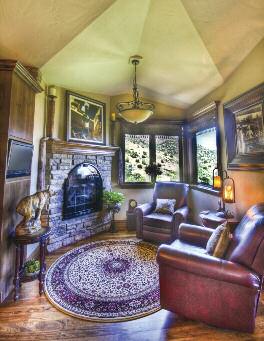
Photo by Wendy Gedack
Which is a good thing…because when my design team is hired to build a Man Cave in a new or existing home, I need husband and wife on the same page. When a wife tells me, “I don’t care, the basement’s his, just do it,” that’s a huge red flag—just as it is when a husband says, “I don’t care, my wife makes all the decisions, I just want the house decorated.” I have yet to encounter the couple that doesn’t want significant (if not equal) input on a design project. Better to come to a meeting of the minds in the planning stage, because once the build-out begins, changes can get contentious and expensive.
I always start with the assumption that a couple shares similar tastes. Sometimes, it doesn’t seem that way, but at the end of the day they’re usually not that far apart. They may have different visions for a space, but if you listen carefully, you’ll find that common ground. I typically do a three-hour consult and also ask prospective clients to fill out a detailed questionnaire. Occasionally, I’ll have to employ techniques a psychologist would, but it’s really critical to get everyone on the same page. My job at that point is to evaluate the space, to determine what’s going on in with rest of the house in terms of architectural style and color, to understand how people relate to the different spaces, and then continue that into the Man Cave. Continuity is really the key. Whatever you do in that Man Cave has to marry with the rest of the house. That’s where the magic happens. You don’t want it to look like What exploded in that room?
One of the mistakes people make when they start a project like this is to tear out pictures from architectural magazines and say, “I want that.” What’s big right now in the interior design business is finding eclectic touches and working them into a space. That’s particularly true for a Man Cave. I saw a story about a home that belonged to the director of one of the Batman movies. He had a full-size Batman model that would have looked terrible standing by itself in any other part of the house. But the entire room was designed intelligently and tastefully and it looked great. That’s why eclectic items work really well in a Man Cave. It really personalizes the space. If that item
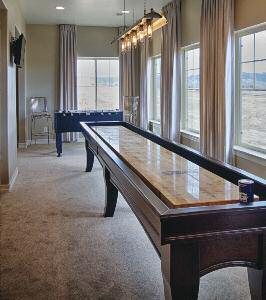
Photo by Wendy Gedack
is a neon beer sign, well, that may present more of a challenge than a deer head or an autographed jersey, but you can definitely pull it off. Even if you don’t have that one off-the-wall detail to work with, in an ideal situation you like to start a Man Cave with a focal point—a pool table, a fantastic piece of furniture, a large collectible item—that’s Design 101. More often than not, however, your client just says, “Just create a space that blows me away.”
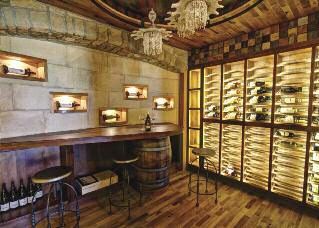
Photo by Wendy Gedack
In those cases, again, it’s important to listen. You’re trying to find a way to bring his things and her things together in a space, especially if the Man Cave is a place that a couple is going to share and entertain in. Recently I had clients where the husband and wife were both Starbucks executives. He grew up on a farm in Minnesota. She was a city girl from Chicago. He wanted warm tones and lots of wood. She liked glass and steel and cool colors, and really disliked wood.
Immediately, I knew I had to figure out what they both liked. In our discussions, it turned out she was very focused on her wine collection, and was keen on having some sort of storage configuration in their dining room. At the same time, he liked sports but his Man Cave didn’t have to be full of Broncos memorabilia. He just wanted a really cool, refined space—”a place where I can smoke a cigar, have a mug of beer and enjoy the space.” I ended up using two basement storage areas to create a wine grotto. It had the wood that he wanted and enabled her to show off her collection in a space they were both comfortable in. He feels good about it because he can have his buddies over, and she’s happy because the shelves we built were tilted at 45 degrees so that people could see the labels of the wine bottles.
Of course, not everyone can afford to hire an interior designer to plan out a Man Cave. If you are tackling this project yourself, there are a few rules of thumb. Limit yourself to two or three colors. Ideally, carry through the main color of your house into the space, and pick one or two others. If one of those colors is a bright team or school color, that may present a challenge—but also an opportunity. For the “NFL Female” Super Bowl Party, I purchased a black and white cowhide, Googled “chalk paint by Annie Sloan” and found a local stockist who painted it orange crush and blue (see below) and it really pulled the room together. Another way to get continuity with the rest of your home is in the matting and framing of photos and collectibles.
Most importantly, re-read the beginning of this article. It’s critical to get on the same page as your spouse. Understand what’s important and what’s not, and pick your battles wisely. You’ll end up with a space you’ll both be happy with.
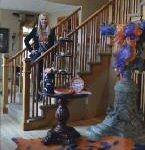
Photo by Elizabeth de Sordi
Editor’s Note: Stacy Ewing runs Stacy Ewing Interiors & Design in Denver. The company works from concept through completion for a wide range of residential, commercial and hospitality projects. Stacy has designed Man Caves for six residential clients in recent years. Many of her past and current projects can be viewed at stacyewinginteriors.com.
Amuse
39 Elm Street, Westfield. Phone: 908.317.2640
Open for lunch Monday through Saturday from noon to 3 p.m. and Sundays for brunch from 11 a.m. to 3 p.m. Dinner, Monday through Thursday from 5 to 9 p.m., Friday and Saturday from 5 to 10 p.m. and Sunday from 5 to 8 p.m. BYOB.
Dress ranges from smart casual to festive. Prices: Soups and appetizers: $8 to $24. Entrees: $20 to $42. Desserts: $8. Major credit cards accepted.
Roasted bone marrow doesn’t need to shout. Its slithery texture, its unabashed tout of fat, its sturdy boat of a bone as conduit is so dominant a presence on a plate and on a menu that, without a word spoken, “French bistro” is conveyed.
Amuse, a spanking new French bistro in downtown Westfield, has bone marrow on the list of starters on its menu and it pops out at diners. Even before you see foie gras, steak tartare, escargot and frisee, your eyes light on “roasted bone marrow (with) sea salt, red onion marmalade, toast.” It’s so proper, it’s so right.
It’s also not surprising, for Amuse is the down-to-earth confection of Chez Catherine veteran C.J. Reycraft. A casual counterpart to the formality of Westfield’s longtime French fine-dining fortress, Amuse is new-school bistro, cheerfully decked in blond wood tables and chairs, with a handful of booths lining a rear wall and a modern “chandelier” that serves as a playful spoof to dripping candelabra.

Photo credit: Manny Carabel/MTC Photography
Amuse is Reycraft’s personal statement, a way of saying “bon appetit” without sounding haughty. It’s French bistro with an American look—clean-cut white tableware and linens, paned doors that serve as windows opening out onto the street, artwork in small doses. It’s a look that’s spare and calm, no frills, no ruffles, no fuss.
The food doesn’t appear fussed over, but it is carefully prepared. That bone marrow, stately and imposing with a pair of bones pitched in a cross formation on a stark white plate, comes with a riveting red onion marmalade that, rich and succulent as it is, actually serves to tame the silky marrow. Slather both atop the toast, then sprinkle with sea salt and understand why classics come to be: Some things are just too delicious to go out of style.
The frisee salad, topped by a perfectly poached duck egg, smoky-meaty lardons and crisp croutons, was spot-on. Poke open the yolk of the egg to let it ooze atop the bitter greens and lardons, then toss the lot into the Champagne vinaigrette. Super-size that salad and call it lunch. Or a post-theater midnight supper.
Reycraft’s foie gras is seared and served with brioche and a vanilla-licked pear compote that didn’t even approach sweet. The pear, just shy of ripe, was astringent enough to dial down the inherent hyper-richness of the fattened liver, and a flash of almonds brought crunch to every bite. Texture, in the right places and in the right doses, is something a smart chef understands.
Cashews brought that same touch to the mild ricotta-stuffed ravioli dressed in brown butter. The happy surprise here was a hint of tart-sweetness coming from a quick spray of chopped cranberries. I love dining out for such ah-ha moments: Why not just a touch, the barest touch of dried fruit with that pocket of cheese-filled pasta? It made the dish taste finished, complete and, ultimately, special.
A dining companion was tickled to find beech mushrooms perched on the plate of duck confit and butternut squash puree with a sprinkling of dried cherries. She loved seeing these creamy-tasting wild mushrooms she’s acquainted with from her native Japanese cookery, while I was just as happy to find them a yin to the yang of the preserved duck leg and thigh’s crackling skin that yielded to tender and intensely flavored meat. Too often, residual salt mars duck confit, but not here at Amuse.
The seared sea scallops, however, were seriously oversalted, as if someone in the kitchen had generously salted them and then another chef had unknowingly salted them a second time. The promising accents—hazelnuts and raisins, capers and browned butter—were obscured by the salt. We lapped up the sides of buttery pureed parsnip and Brussels sprouts as a cleanse.
The steak frites triumphed. Hard-fought simplicity is what this classic of beef-and-fries is about and Amuse’s take—employing a chewy, deeply beefy skirt steak, a hip-yet-comforting choron sauce and, for a kick, kohlrabi—is plain old cooked-to-a-T fun.
If you’re all about high-art desserts presented as high-wire acts that demand surgical tools to merely approach, Amuse’s finales may disappoint. I loved them, particularly a banana pudding so custardy that it made me wonder just what the ratio of bananas to eggs was in this pudding. Factor in a chocolate cookie crumble of a crust and you’ve got a very grand finale. A pair of tarts can’t be considered also-rans: The chocolate tart, lined with caramel and finished with a layer of dark ganache, came with a dollop of passionfruit ice cream that reined in the richness of the confection. The lemon tart, with a textbook-true lemon curd at its core, was paired with a snappy raspberry sorbet. Again, balance. Again, impressive.
Amuse charms with its unassuming style, devotion to classics that deserve the title and sophisticated home-spun character. Too often, chefs who lack experience and confidence feel the need to riff on classics in a way that deprives them of their soul. Chef Reycraft takes liberties, but only in ways that elevate the dishes. That’s a chef with a clear vision and the chops to see it through from concept to kitchen to table.
 Wine Times
Wine Times
Amuse, very much a French bistro, is a BYOB. This means you should not tote along mass-manufactured bottles from the New World. Save Barefoot, Yellowtail and Cupcake for another time. (Though, frankly, I wouldn’t wish another time of that kind on anyone.) Amuse deserves a wine not so much from the trophy zones of Burgundy and Bordeaux, but rather the Languedoc, the Loire and the southern Rhone Valley of France. Since rose season is upon us, spring for a Provencal rosé—or, for typically less cost, one from Nimes. What you want is a true bistro wine that goes with a good variety of dishes. Carignan, anyone? Yes, if it’s from a good producer in the Languedoc. A Grenache blanc blend? Now you’ve got the right idea.
“Makeda ups the ante for restaurants that aim to do right by other than animal products.”
338 George St., New Brunswick. Phone: 732.545.5115
Hours: Lunch, Monday through Friday from 11:30 a.m. to 4 p.m. and Saturday from noon to 4 p.m. Dinner, Monday through Thursday from 4 to 10:30 p.m., Friday and Saturday from 4 to midnight and Sunday from noon to 10:30 p.m. The bar is open until 1 a.m. on weeknights and until 2 a.m. on Friday and Saturday nights. It’s open until midnight on Sundays. There is live music on Friday and Saturday nights. Reservations are accepted, as are all major credit cards. Prices: Appetizers and salads, $7.50 to $15.50. Entrees: $24 to $37. Vegetarian entrees are $15 to $25.50.
I wasn’t surprised when a professor pal of mine at Rutgers suggested Makeda as our lunch spot: We both love learning, adventure at the table, and foods that take us away from anything resembling an edible routine.
Makeda, the first Ethiopian restaurant to make a fine-dining statement in New Jersey, is a natural for New Brunswick, a college town that plays home to both mainstream and ethnic restaurants, lavishing equal affection on well-played versions of the normal and the novel. My friend and I were in complete agreement: Why grab a sandwich billed on a thousand menus when we could gab over fare rarely offered elsewhere? Makeda it was.
It’s a restaurant that pops into my mind whenever I want to veer from anything standard-issue. It tends to delight newcomers even as it defies expectations, for the menu is a trip to a land of new ingredients and new juxtapositions of familiar foods.

Photo credit: iStockphoto/Thinkstock
The eating itself flies in the face of American tradition. The conduit of food between platter and mouth is Ethiopia’s beloved injera bread, a spongy, grainy number that’s something like a thick, large crepe in appearance, but tastes engagingly sour and is used to scoop up pretty much everything served at Makeda. That mild lemony flavor clicks on all cylinders with a variety of headliners, including lamb, chicken, seafood, beef and vegetables. Every time I’m at Makeda and wrap strips of faintly sweet lamb with vigorously seasoned onions in a torn-off piece of injera and warm to the scheme of everything-in-one-bite, I wonder why more contemporary chefs don’t steal from Ethiopia’s culinary playbook.
That’s exactly what friends who went with me one recent night to sample around Makeda’s menu thought. And if they were hesitant about diving into the communal platters concocted by the kitchen so we could better share the diverse dishes we’d ordered, they certainly didn’t act a smidgen shy.
Minchetabesh, ground sirloin infused with cardamom, garlic and ginger, and liberally doused with white pepper, is pan-seared with sliced onions to make it ready for rolling in the tangy injera. Though the concept may have you thinking hamburger, the finished dish is high-toned and beguiling. It offers the same attitude as the zil-zil, those strips of lamb marinated in Ethiopian honey wine with onions and garlic, then fried in butter which makes the meat crusty, but locks in the seasonings and juices. Cosseted in the injera, it’s something my dining companions can’t stop eating.
We can’t stop talking about how plain old delicious the doro wat is, a classic Ethiopian entrée of bone-in chicken parts that have done time in a lemon marinade before being briskly sautéed with the reigning triumvirate of fenugreek, ginger and garlic. The dish is finished with a dash or three of berbere, a feisty spice mixture that’s heavy on the ground chilies but tamed by baking spices – nutmeg, cinnamon and cloves. We slice the hard-boiled egg served with our chicken and tuck every component of the dish into the foamy bread. My pals have gotten the hang of what, only a short time earlier, was newfangled finger food.
Ethiopian food is vegetable- and pulse-centric, and Makeda ups the ante for restaurants that aim to do right by other than animal products. Take the mesir wat, lentils and onions slow-cooked with garlic and ginger in a berbere that’s calmer than the chilies-rich mixture used in the doro wat. It’s both comforting and cunning, a stew that’s decidedly rustic, but sophisticated in its layering of multiple warming seasonings. If you want more vigorously spiced lentils, go for the mesir azefah, which plays green lentils off a hotter backdrop of accents that include jalapenos, mustard seeds and white pepper. Served cold, it’s something you might want to share as a starter.
Speaking of which, appetizers aren’t part of a typical meal in Ethiopia. So the kitchen crew here, guided by owner Ogbe Guobadia, borrows from cuisines in North Africa, most notably Morocco, for its starters and even throws in a salad or two. Skip the salads, which truly do seem out of place, and kick off dinner with loubia, a sauté of string beans in lots of parsley given a lift from cumin, ginger and garlic. They’re pleasingly soft, as many vegetables are in the Middle East, Eastern Mediterranean and North Africa, and work in tandem with the zaalouk, a perky chop of eggplant pan-fried with the same accents, then sprayed with fresh lemon juice before hitting the plate.

Photo credit: iStockphoto/Thinkstock
I usually snag the kefta when dining at Makeda, finding those Moroccan meatballs powered by crushed red pepper irresistible, but this time out I ordered a accented opener of shrimp simmered in peppery orange juice, then served with wedges of orange juice and tomatoes. The shrimp were overcooked and the orange not integrated into the shellfish. Next time, I’ll stick with the meatballs.
I wish Makeda wouldn’t stick to its all-American desserts. The folks here can do better than carrot cake that’s done too much time poorly covered in the fridge. Even if it’s something very simple—again borrowing from Morocco—such as cookies studded with nigella seeds or oranges in orange flower water, it would do more in keeping with the mission of Makeda. Right now, there are no grand finales at a restaurant that deserves a rousing finish.
Makeda, born in 1996, is a fixture in New Brunswick. People who live in the city, those who work at or attend Rutgers, are proud to show it off to visitors: It’s unlike anything else in the state, it sports a lively scene—especially on Friday and Saturday nights when live bands take center stage—and it proves restaurants in New Jersey aren’t always focused on Italian-American standards. Give Makeda an “A” for inspiration.
Editor’s Note: Andy Clurfeld is a former editor of Zagat New Jersey. The longtime food critic for the Asbury Park Press also has been published in Gourmet, Saveur and Town & Country, and on epicurious.com. Her post-Sandy stories for NBCNewYork.com rank among the finest media reporting on the superstorm’s aftermath and recovery.
 Exotic Collegiate
Exotic Collegiate
If you ever went to Tumulty’s in the old days, Makeda may strike you as a brave new century in college town dining. It’s got the requisite large and happy bar and a space that, if the ceilings weren’t so high, could be called cavernous. But comparisons to a typical collegiate hangout stop there.
Makeda sports African artwork through its dining spaces, both in the private rooms and the main dining areas. A long banquette fronted by tables for two (or four) is upholstered in colorful fabric that avoids stereotype but feels vividly African. The wood and glass that define the spaces are angular and striking. It’s a scene that melds modern times with Ethiopian/African traditions.
How to turn your second home into a third one. And fourth one. And fifth one…
By J.M. Stewart
There is a new kind of “key party” happening out there. Chances are, you already know someone who’s doing it. Hold on—it’s not what you think. The only things being swapped are the keys themselves. The Home Exchange industry has taken off in recent years, thanks to a combination of factors that have convinced thousands of vacationers to look at their vacation dollars in a completely different way.
 Technically, home swapping is nothing new. It has been around for a while. The basic idea is trading vacation time in your home for vacation time in someone else’s. This can be done in a few different ways with different types of properties. In most cases, however, owners of second homes are bartering unused time in their vacation properties for unused time in other people’s second homes. Who wouldn’t want to trade that sparsely used month at the Jersey Shore for a Paris apartment or a hilltop mansion overlooking the Caribbean?
Technically, home swapping is nothing new. It has been around for a while. The basic idea is trading vacation time in your home for vacation time in someone else’s. This can be done in a few different ways with different types of properties. In most cases, however, owners of second homes are bartering unused time in their vacation properties for unused time in other people’s second homes. Who wouldn’t want to trade that sparsely used month at the Jersey Shore for a Paris apartment or a hilltop mansion overlooking the Caribbean?
More than 20 home exchange companies have sprung up in the last two decades, which tells you some-thing about which way this industry is headed. Not coincidentally, during that same time the timeshare industry has cratered. A major reason for the rapid growth of home exchange clubs is the Internet, which enables home-swappers to peruse vacation properties, read personal reviews, and upload comments and photos of their own after each stay.
According to Steve Zacks, a principal at 3rd Home, a leader in the luxury segment that features over 1,700 residences with an average value of $2.25 million, “There is complete transparency in the program.” The company’s web site features comprehensive listings on each home, and guests are encouraged to write a review after each stay—which is then featured unedited on the property page and in the testimonials section.
There are three basic types of home exchanges:
- Hospitality Exchange You stay in someone’s home while the host is there. This might be in a spare bedroom—bed-and-breakfast style—or perhaps a guesthouse. It is an interesting budget option.
- Simultaneous Exchange This is when you literally switch homes—you’re in their home, and they’re in your home at the same time. Companies like IVHE Vacation Home Exchange, in England, function as facilitators. People who like this option find it interesting to vacation in a home filled with someone else’s personal belongings.
- Non-Simultaneous/Non-Direct Exchange You “pool” your vacation home availability with like-minded individuals and then pick the property you want to visit, at a time when you want to travel. It is not your responsibility to find someone who wants to trade with you. This type of service is offered by the elite-level home exchange companies. The vacation properties in pooled exchanges can be valued from $500,000 into the millions, and have club rules, regulations and controls in place to promote a consistent luxury experience.
SO, WHO’S STAYING IN MY HOME?
Good question. Luxury companies vet potential members through referrals and social networking. Every member must comply with the terms and conditions set forth in a company’s guidelines. Non-compliance can result in expulsion. But according to Zacks, “Members pay it forward. It is a private club. Our members, all of whom have their vacation homes in the program, treat each property they visit as if it were their own. Many have created new friends in the process
In less-exclusive simultaneous exchange situations, it is up to the homeowners to work things out. This involves a fair amount of personal contact—and also being comfortable with strangers occupying your primary residence. It’s not for everyone, but for some this is part of the adventure. As one happy swapper says, “When I talk to my exchange partners either on the phone or over the Internet, I just use my gut to get a sense of them. And, I take common-sense precautions, like putting our valuables in an off-limits room when people stay here. My family and I have been doing this for years now, and we’ve never had a problem.”
3rd Home is representative of the high-end home exchange companies in that it only handles second (or third, or fourth) homes. Love Home Swap, by contrast, will work with primary homes, which can involve some tricky logistics. Many companies do a little of both, including IVHE out of England. Others still, like Air B&B, can arrange a room swap. Needless to say, however you go, it is an economical way to travel because you are paying a tiny percentage of typical resort charges or house-rental fees
 THINKING LOCAL
THINKING LOCAL
There is an ancillary benefit of home exchange to surrounding economies: An empty home generates no revenue for nearby businesses, while a home occupied for a couple of weeks by a family that has saved a bundle in rental fees will be a big win for the local shops, restaurants and other tourism-reliant enterprises.
Business is booming in the non-simultaneous exchange sector. Among the many reasons for this growth is that a lot of people built or purchased second homes as investment properties during the real estate boom of the last decade, and now find themselves unable to resell, rent or use the homes as frequently as they had originally anticipated. Or perhaps they have had many years of enjoyment and now are ready for new experiences. Filling those homes with like-minded vacationers—while racking up credits for your own vacation adventures—makes sense. On the flipside, as the person doing the vacationing, you save thousands of dollars in a single trip, and can bring the entire family (and even a couple of friends) to boot. Indeed, in many parts of the world, you might be amazed to find vacation homes with between 5 and 10 bedrooms.
Depending on the company, the cost of vacationing in a fabulous home in an exotic locale averages between 5 to 10 percent of the rental cost were you to go through a local realtor on a short-term stay. In addition, all companies charge some sort of membership fee to be part of the program
POINT TAKEN
Trade to Travel and 3rd Home run on point systems. You get out of the program what you put in. For example, Trade To Travel requires a one-time-only initiation fee of$2,500, but if you make your home available right away (within the first six months of joining), this fee is waived. The more weeks you offer up your house—and the more often your home is used—the more points you accrue. These points are then “cashed in” for a trip. 3rd Home employs a similar kind of credit system that takes into account the value and location of your home, as well as the time of year the home is made available. A high season like Spring Break will garner more credits than a less in-demand time of year. One of the more appealing aspects of this arrangement is that homeowners begin racking up credits the moment unused blocks are deposited into the system, and thus can book their own vacations right away. It’s an economy unto itself.
Timing is everything, of course. If you are considering a home swap, it’s best to plan a trip to, say, Europe at least 3 or 4 months in advance, just to allow yourself the opportunity to pick from a greater variety of locations. Some of the choicest properties come off the board a year in advance. Remember that many of these homes are listed as vacation rentals with local realtors, and the owners of these homes still use them for their own vacation time, so it’s not just home-swappers vying for them. Most companies accept a one-week minimum visit to a home. One home exchange company reported a stay that lasted 6 months. Now, that’s a vacation!
When it comes to luxury properties, there are basically two distinct tastes among travelers. Some want the total residence-club experience, while the more adventurous prefer to go native and fly solo. No problem, several companies cater to both of these personalities. If you’re in the mood for a little pampering, but still want to live like a local, many vacation homes include a staff to cook and/or clean for you. And every home has some sort of local contact or caretaker to answer questions and deal with emergencies. Also, homeowners typically provide a long list of instructions and recommendations for their guests. For those who prefer the top-flight amenities a hotel offers, the higher-end companies have affiliate relationships with residence clubs and developments. 

Special thanks to
3rd Home for supplying
the images for this story.
NOT FOR EVERYONE
As appealing as home exchanges sound, they are not for everyone. If you are the kind of person who needs to adhere to a strict timeline with a very specific locale, home exchange programs might not be for you. If you neurose over other people using your things—even if they’re just your “vacation things”—then, again, home exchange may not be a good fit.

However, if you are flexible in your schedule or location, you can go to top-notch destination spots with great frequency for a fraction of the price.
3rd Home, for example, is affiliated with Trump International and includes Trump International Hotel and Towers in New York, the Reefs Club in Bermuda and The Residences at the Chateaux in Deer Valley.
Thanks to home exchanges, enjoying the carefree life of travel and staying in some tremendous properties has never been easier. Pick a club t

o join, list your home, and then start looking for your next vacation destination. Not only will you save buckets of money but, as one homeowner put it, “It feels great to put my empty vacation home to work for me…instead of vice-versa.”
The last line of defense at the Super Bowl is not what you think.
By Alison Hemstitch
You wouldn’t believe the things a “house doctor” sees at a football game. So says Dr. Kevin Lukenda, Chairman of the Family Medicine Department at TRMC. Dr. Lukenda has been working two to three events a month at the Meadowlands Sports Complex for a dozen years.

Photo credit: iStockphoto/Thinkstock
MetLife stadium holds 85,000 people including employees. When the stadium sells out a football game, concert or soccer match, it is essentially a small city with the same potential for 911 calls and problems that a city would encounter on any given day. The Meadowlands Sports Complex has its own EMS, Fire, Safety Services and Maintenance Departments, among others. The physician on duty for an event handles everyone’s medical problems—from colds to falls to life threatening situations such as heart attacks, strokes and diabetic emergencies. The staff also sees its share of stadium-exclusive issues, like moths dive bombing into the ear canals of guests sitting in the upper level near the lights.
So what does Dr. Lukenda consider a normal day at a New Jersey sporting event?
“Respiratory and cardiac issues are the normal fare,” he says. “Essentially our fans bring a full complement of their chronic illnesses with them to events at the Sports Complex, some of which are exacerbated by the weather, walking a distance into the buildings, or the food and beverage they consume at the tailgate parties they attend. Tailgate parties can be quite elaborate, fully catered affairs.”
The Meadowlands Sports Complex, which is owned by the state and managed by the New Jersey Sports and Exhibition Authority, is the only sports venue in the state that has its own Medical Team of physicians, nurses, EMTs and ambulances that are managed by a Medical Director, EMS Director and EMS Coordinator, who plans the EMS coverage for all the events.
For the Super Bowl, Dr. Lukenda was one of eight physicians stationed in various medical rooms throughout the stadium. This job required the physicians and staff to have in-service training prior to each NFL game this season to prepare them for anything that might be thrown at them come the Super Bowl game.
Normally, Dr. Lukenda’s job is to administer to fans and employees, but after rock concerts, he is occasionally called upon to treat a performer. “Some of those guys leave it all out on the stage and come back to their dressing room spent or dehydrated,” he says (but won’t say who). “These acts go on tour and depending on how long they have been touring, they start to get ill from the long hours and the demands of the road. We are their on-the-road, so to speak, physicians. What a rush when you first get to treat a celebrity.”

Kevin Lukenda, DO Chairman, Family Medicine Department, TRMC 908.925.9309
Dr. Lukenda says, “I love working at the Sports Complex. It is a totally different feeling than the office and hospital. You get a bit of an adrenalin rush being so close to the action.”
 CHAMPS IN CAREGIVING
CHAMPS IN CAREGIVING
Dr. Edna Bacarro, Certified Nurse Midwife Marietta Jones, and RNs Danielle Passafiume and Cecilia Amaro display the hardware they brought home from the 2nd annual SimWARS at the Regional Perinatal Simulation Center at Saint Barnabas Medical Center. The Trinitas OB/GYN team members finished in first place, surpassing the competition in teamwork, communication, and clinical decision-making abilities in a patient care setting that used high-fidelity simulated patients.
 KING FOR A DAY
KING FOR A DAY
Friend of EDGE Ron Shovlin shows off his newly named Shovlin Mattress Factory. The company is located in Fanwood and has been producing mattresses—right here in Jersey—for over 30 years.
 THE VIEW FROM THE TOP
THE VIEW FROM THE TOP
HealthcareIT News, published by Health Information Management and Systems Society, recently announced that in its 3rd Annual “Where to Work” Best Hospital IT Departments Program, the Information Technology (IT) Department of Trinitas topped its list of 10 Best Hospital IT Departments nationwide among medium-sized hospitals having 26 – 75 members. This bested the Trinitas IT department’s previous ranking in the 2012 Top 10 list.
 KNOWLEDGE IS POWER
KNOWLEDGE IS POWER
Trinitas’ own Lucy Esralew, PhD, administrator of the S-COPE (Statewide Clinical Outreach Program for the Elderly), will assist the Felician College External Advisory Board for the Institute for Gerontology as it examines its role in addressing the needs of the aged. As developer of S-COPE, Dr. Esralew established the state-wide network of clinicians who help nursing homes and assisted living facilities respond to senior mental health needs.
 GRANT EQUALS HELP
GRANT EQUALS HELP
The Hospital Elder Life Program (HELP) at Trinitas now reduces cases of hospital-acquired delirium among the senior population. A multi-disciplinary team of healthcare professionals has successfully reached more than 550 patients since March 2013. The Hospital-Acquired Delirium Project was made possible by a$100,000 grant from the Healthcare Foundation of NJ.
HELP Intervention Assistant Diana Noboa and HELP volunteers Adriana Dominguez and Rosa Alexandra spend time with patient Armande Samanamud.
 MOONLIGHTING
MOONLIGHTING
Union County Clerk Joanne Rajoppi celebrates publication of her new book, New Brunswick in the Civil War: The Brunswick Boys and The Great Rebellion at the Towne Book Store in Westfield. Rajoppi is flanked by two new fans, Paula Long of Westfield and Christine Bennett of Summit.
 CODES RULE
CODES RULE
Have you ever suffered a bite from an animal, crustacean or another person? Thankfully, there are numbers assigned to the more than 60,000 new codes of the World Health Organization’s latest version of its International Classification of Diseases (ICD). As information management meets patient care and safety, here’s hoping that Trinitas won’t be treating anyone suffering from ICD-10 W52.0…a human bite inflicted during a stampede!
 MORE THAN A BAND AID
MORE THAN A BAND AID
New Jersey hospitals serve 18 million patients each year, regardless of their ability to pay. According to the New Jersey Hospital Association’s (NJHA) 2013 NJ Hospitals Economic Report, the state’s hospitals contributed a record $20.4 billion to the Garden State economy in 2012. As a safety net hospital, Trinitas provided in excess of $46,000,000 in charity care, $2,000,000 more than the federal and state allotments it receives to meet the needs of the uninsured and underinsured.
It’s March 1st…Do you know where your kid’s ‘camping’ this summer?
By Diane Alter
As competition for summer sleepaway camp dollars becomes more extreme, so too does the range of camp experiences. While you may not want to send your kid to Ninja Camp or Explosives Camp (yes, they do exist) a growing number of parents are picking places that push the envelope and promise to explore the limits of their child’s body and/or intellect in new and imaginative ways. Indeed, more and more parents are packing up their troubles—er—pride and joy, and sending them off to exciting, out-of-the-box summer camps. Some run for a week or two, while others go for a month or more. One interesting trend is the mix-and-match approach, where you cobble together a summer of fun from two, three or four of the shorter-duration camps.
From Culinary Camp in Vermont to Spy Camp in D.C. to Stunt Camp in California to Fiji Shark Camp, today’s camps go beyond classic fun. And unlike back in the day, when mattresses were lumpy, mosquitoes pesky and food tolerable at best, many of today’s niche camps rival the best resorts.
In these pages are some interesting options to use as a starting point. Whether you pick upscale, thrilling, educational, a little of everything or something in between, remember that long after tans fade and badges of honor are shelved, your child’s camp memories endure.
Step Right Up • Camp Winnarainbow
Situated in the picturesque foothills of Mendocino County in Northern California, this 35-year-old camp lets kids ages 7-14 learn every aspect of circus life, from stilt walking to juggling to clowning to riding a unicycle. Kids can also swing on a trapeze, walk a tightrope, learn magic and sharpen their comedic timing. Winnarainbow also features sleeping tipis (teepees) and restaurant-worthy meals. On pick-up day of every two-week session, the campers perform a final show for parents and friends.
Camp Winnarainbow • campwinnarainbow.org
+ Games • Teen Extreme Youth Camp
Teen Extreme Youth Camp in Florida is one of many places around the country that blends spiritual development (in this case, Christian) with non-stop activities. Using the Sports Center facilities on the Pensacola Christian College campus, the camp boasts one of the largest indoor rock climbing walls in the U.S., an inline skating track, indoor water park with surfing and water slides, and paintball competition. Other activities include ice skating, bowling, racquetball, basketball and swimming. Music competitions are also available, as are programs in computer science, art, drama, volleyball, nursing, pre-med, science and history. It’s open to ’tweens and teens grades 7 to 12.
Teen Extreme Youth Camp • teenextremecamp.org

Photo credit: New York Film Academy
And…Action! • Film Academy Camp
So, your kid’s the next Spielberg. Or Denzel. Or Cronkite. Whether a child aspires to a career in acting, filmmaking, musical theater, video design or broadcast journalism, this camp may well be the most intensive, hands-on and authentic in the world. Campuses include Harvard and Yale Universities, Universal Studios Hollywood, and Disney Studios in Florida, Paris, Florence, London and Australia. Camp classes inspire creativity and provide invaluable insider industry insight and experience for students ages 14 to 17. Dazzled by Hollywood guest speakers, campers also attend TV tapings and movie premieres. Bunkmates include the offspring of some of Hollywood’s biggest stars. Lodgings include college dorms and apartments situated across the street from site locations, as well as hotels.
Film Academy Camp • nyfa.edu/summer_camp/

Photo credit: iStockphoto/Thinkstock
Dig This • JurrasiCamp
Forget the plastic dinosaurs and playground sandboxes, JurrasiCamp in Florida encourages kids to get dirty in a quest to unearth genuine dinosaur bones. Campers learn about these legendary creatures and are introduced to them to paleontology—while actively working on digs. Kids even get to take home authentic fossils they excavate from specially designed dig boxes. Other activities include swimming, bowling, and field trips. Open to children aged 5-14, JurassiCamp has been in business as a day camp for 25 years in Miami, Boca Raton and Vero Beach.
JurrasiCamp • funcamps.com
Ups & Downs • Roller Coaster Camp
The only one of its kind in the U.S., this camp takes kids ages 12 to 16 all over the country to ride some of America’s most amazing scream machines. Celebrating 10 years in operation, the Woodbridge (NJ) head-quartered Thrill Coaster Tours offers five-, six- and eight-day roller coaster tours to various parts of the USA. Each day brings a different park and a different stomach-dropping experience of twists, turns, ascents and plunges on diverse roller coaster tracks. Closely supervised groups of six arrive at parks early and stay late. “We do take the kids for a nice dinner somewhere outside of the park to regroup and get them out of the sun before returning for more nightly fun,” Ira Gordon, Thrill Coaster President says. “We’re parents’ answer to a kid’s summer dream of visiting a plethora of amusement parks.” Additional activities include jet-boating, laser tag, rock climbing and more. Stays are at cushy Marriott hotels.
Roller Coaster Camp • thrillcoastertours.com

Photo credit: iStockphoto/Thinkstock
Think Global • West Coast Connection
One of the largest student travel companies in North America, West Coast Connection has been treating teens to summer travel adventures for 32 years. Programs run the gamut from traditional Teen Tours to Community Service Trips to Language Immersion Journeys to Pre-College Enrichment Adventures. North American programs include surfing in San Diego and exploring in National Parks. European programs offer Italian cooking-school lessons, skiing or snowboarding in the Swiss Alps, a gondola ride in Venice, a play at a

Photo credit: iStockphoto/Thinkstock
London theater and swimming the grottos of Capri. Australian adventures include snorkeling on the Great Barrier Reef. Programs in Israel offer the opportunity to float in the Dead Sea and a visit to the Western Wall.
West Coast Connection Student Travel • westcoastconnection.com

Photo credit: Guard Up, Inc
Dead On • Zombie Summer Camp
It’s never too early or imprudent to prepare for the zombie apocalypse, right? Campers at this Massachusetts locale prepare for such a scenario by learning survival skills, basic first aid (invaluable after a zombie scratch), solving life-threatening mysteries, defending their fragile land, foraging for supplies, navigating a maze and fighting off the walking dead using NERF-type weapons. Day camps are offered for kids ages 7 and up, while overnight zombie camps are available for kids aged 10 and over. Kids who prefer not to engage in battle can opt out, and levels of scariness vary.
Zombie Summer Camp •zombiesummercamp.com
SMOOTH JAZZ STYLINGS

More than 150 jazz lovers gathered on November 9th at NJPAC for a one-night only concert of Grammy-winning artists for the 2nd Annual Jazz Celebration. Generous supporters, including renew-ing event sponsors Crothall & Morrison, ensured the event netted approximately $45,000 for the Trinitas Health Foundation.
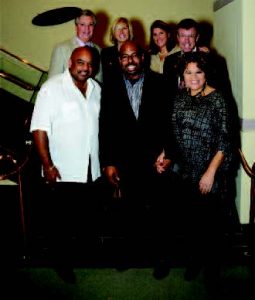
TRINITAS HEALTH FOUNDATION RAISED $14,000 ON GIVING TUESDAY
All Funds Support Pediatric Patients
On December 3, 2013, $14,000 was raised on GivingTuesday. It may seem a little surprising, but no one before designated a specific day to help launch the holiday charitable giving season until last year. All GivingTuesday contributions were directed to the Trinitas Pediatric Health Center. Annually, more than 20,000 children visit Trinitas, their community hospital, to seek care and these numbers only continue to grow.
Every child should have a healthy start to life and Trinitas is there to provide children fr om birth through adolescence with immuniza-tions, preventive, well-child, sick-child and follow-up care through two pediatricians and a bi-lingual staff. “All gifts magically doubled due to the generosity of Foundation trustees Edward Dee, Grant Hobson, Gary Horan, Thomas Kachelriess, Kevin McCloskey, Jan Margolis and Paul Napoli,” said Nadine Brechner, Vice President, Chief Development Officer of Trinitas Health Foundation.
om birth through adolescence with immuniza-tions, preventive, well-child, sick-child and follow-up care through two pediatricians and a bi-lingual staff. “All gifts magically doubled due to the generosity of Foundation trustees Edward Dee, Grant Hobson, Gary Horan, Thomas Kachelriess, Kevin McCloskey, Jan Margolis and Paul Napoli,” said Nadine Brechner, Vice President, Chief Development Officer of Trinitas Health Foundation.
Because of you, Trinitas gives children access to vital health serv-ices ensuring their physical well-being. Thank You for supporting GivingTuesday!
 THE CLARA & SOL KRAMER WING DEDICATION
THE CLARA & SOL KRAMER WING DEDICATION
Family and friends were welcomed to The Clara & Sol Kramer Wing – TRMC’s first-ever wing naming. All joined together to recognize and reflect on the generosity and dedication of the Kramer Family to Trinitas, their community hospital. Almost 90 generous benefactors contributed $500,000 to make The Clara & Sol Kramer Wing a reality.










